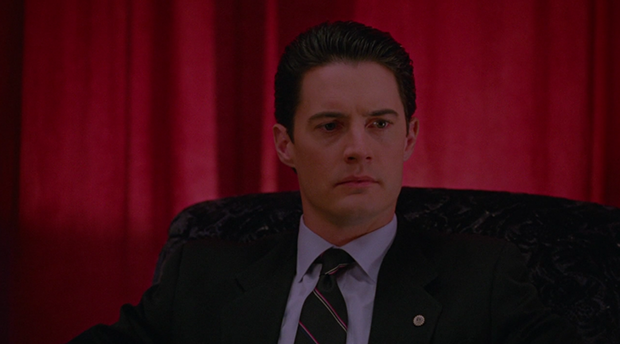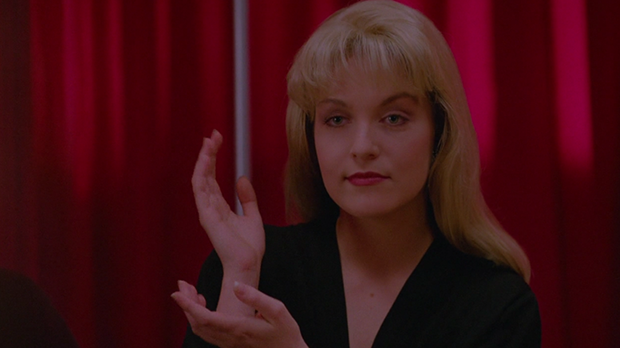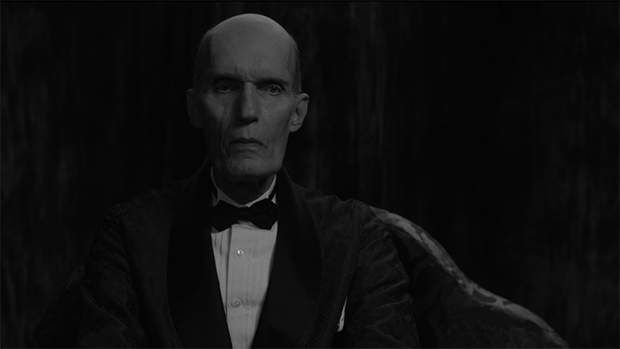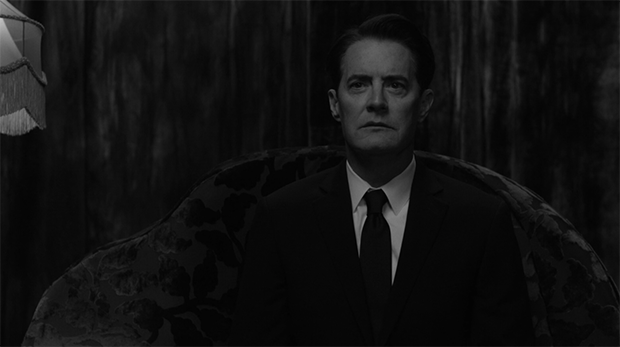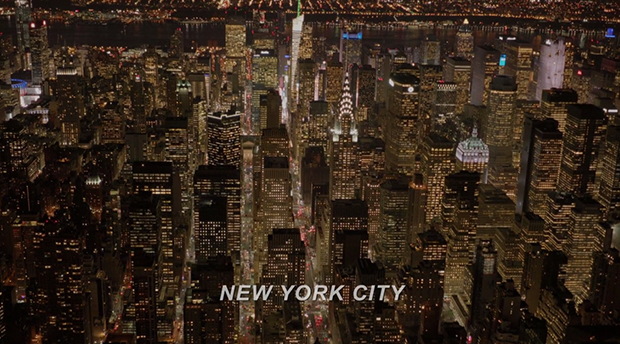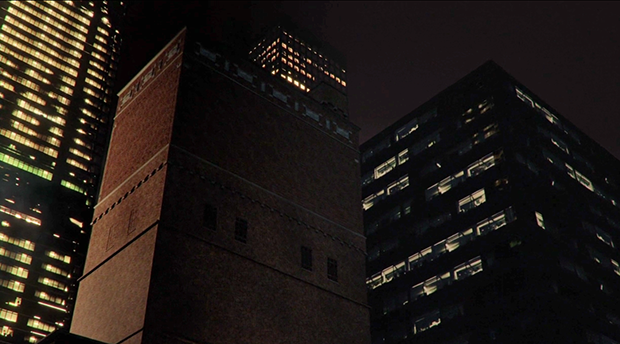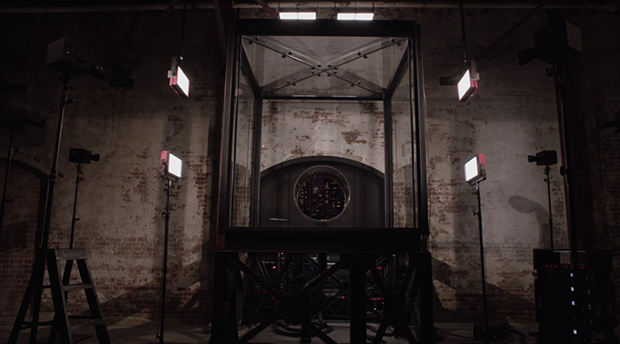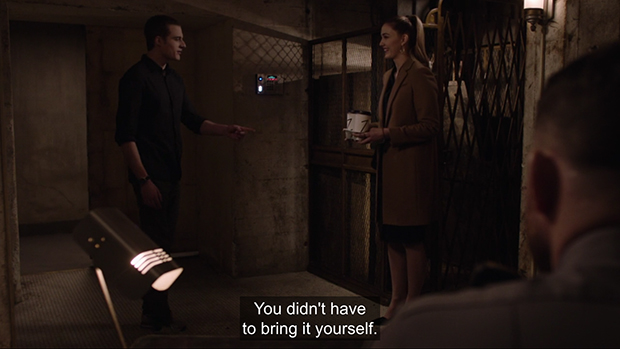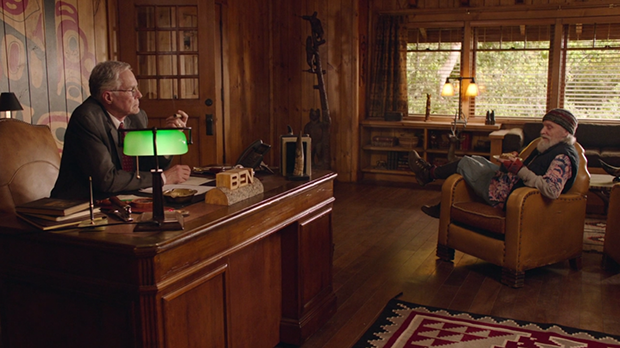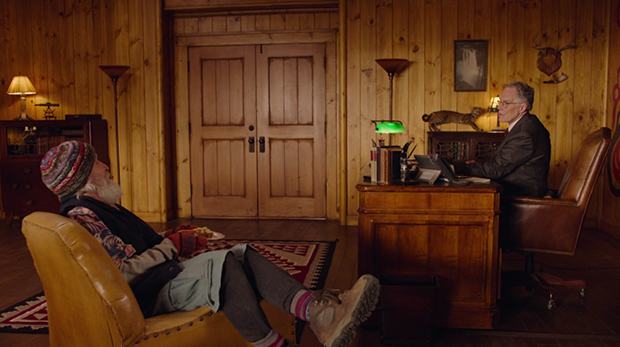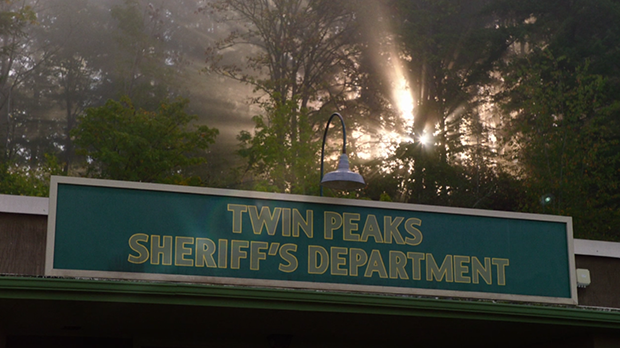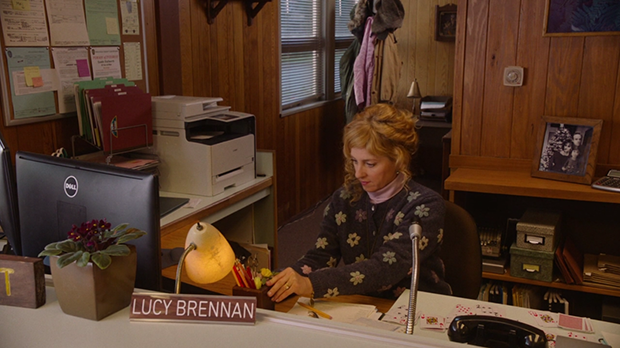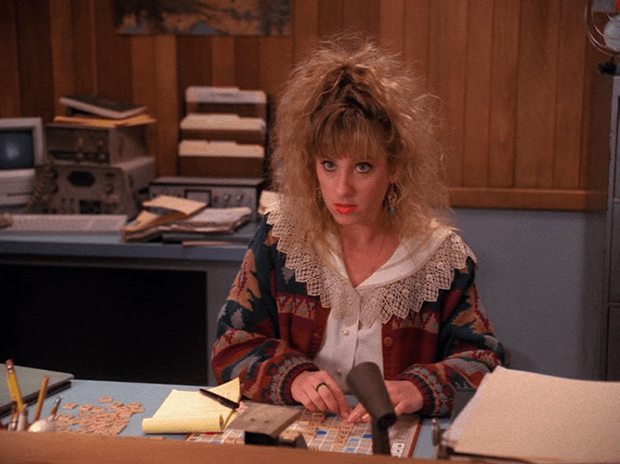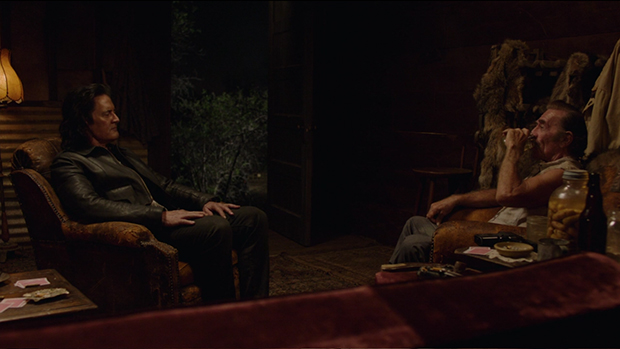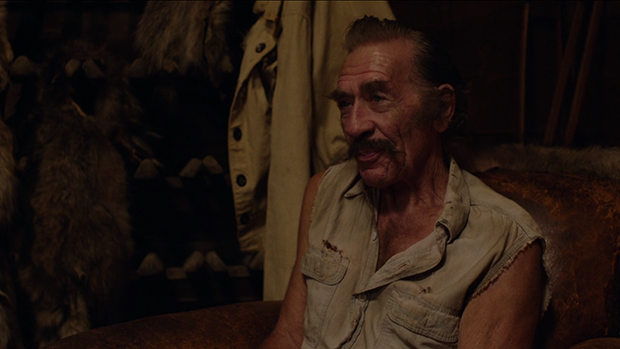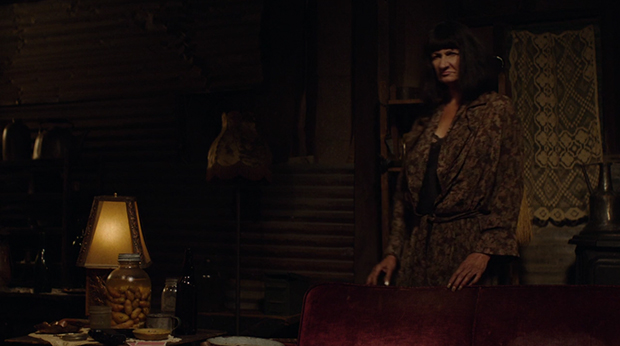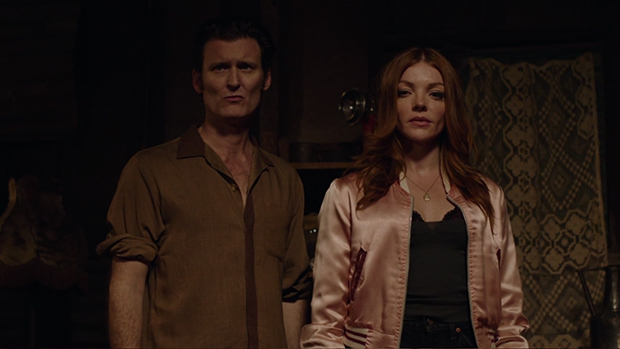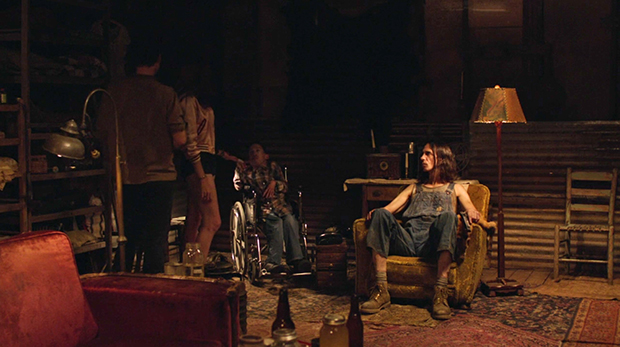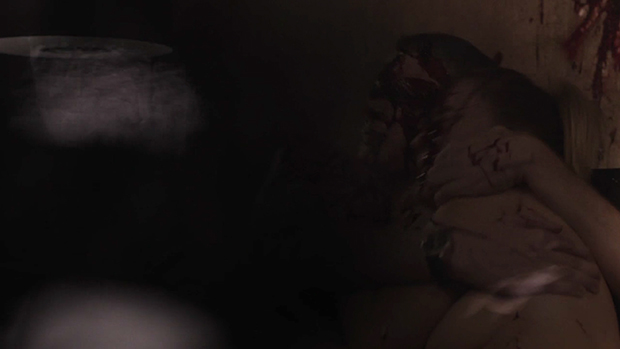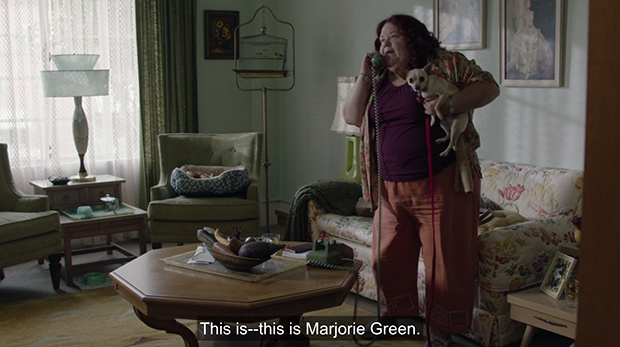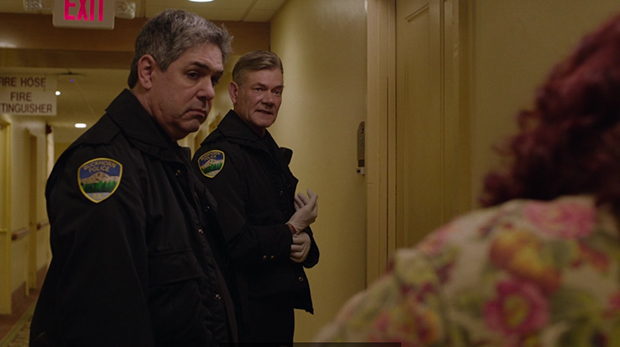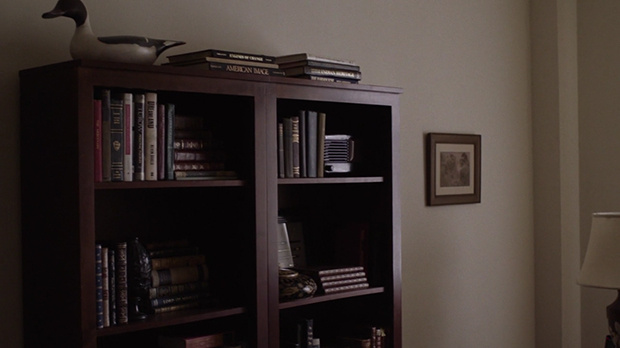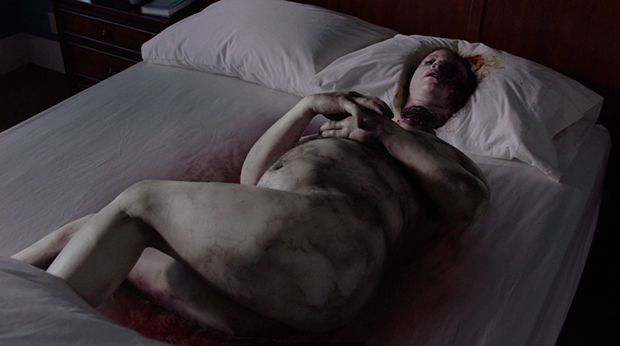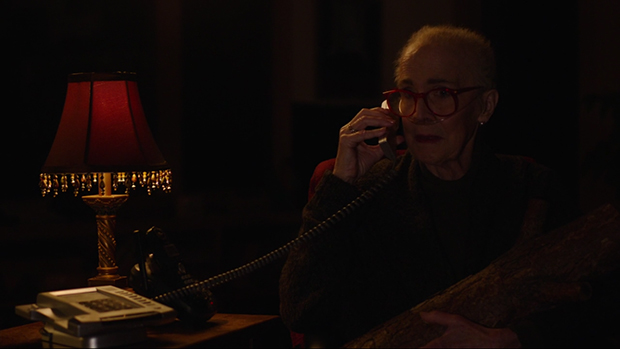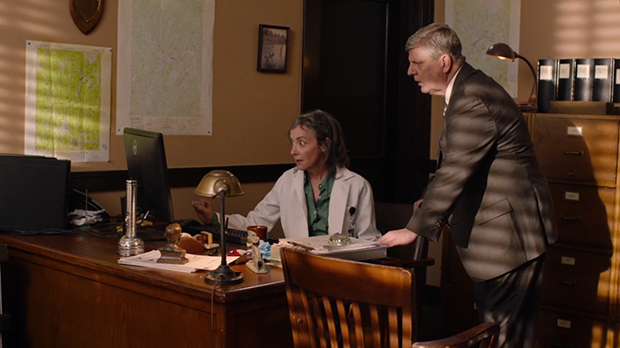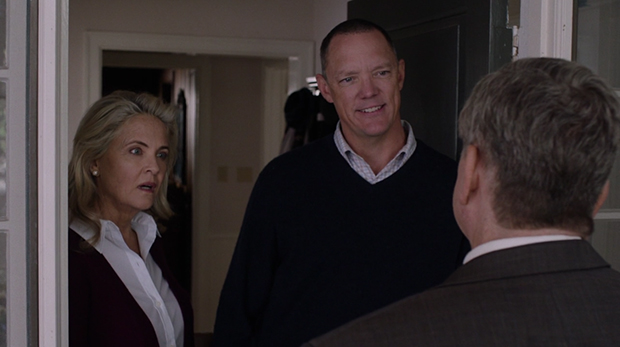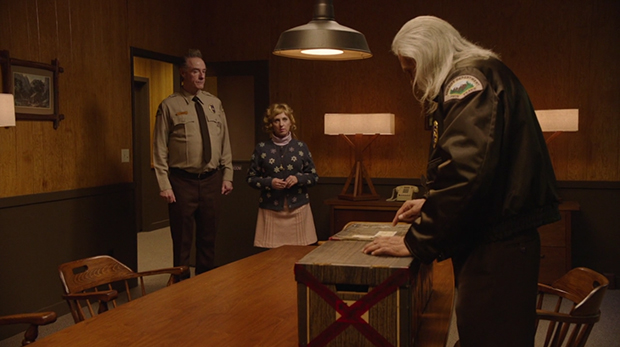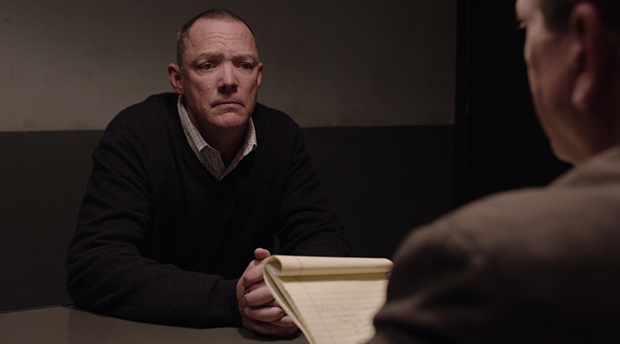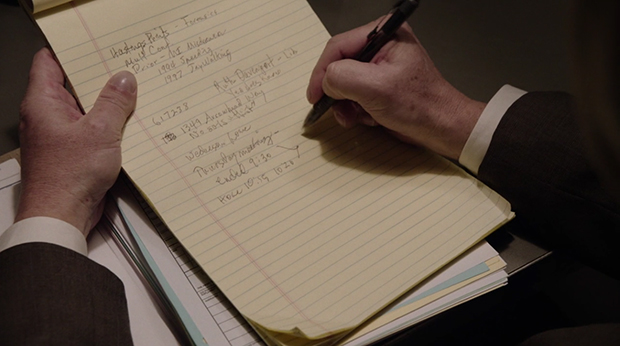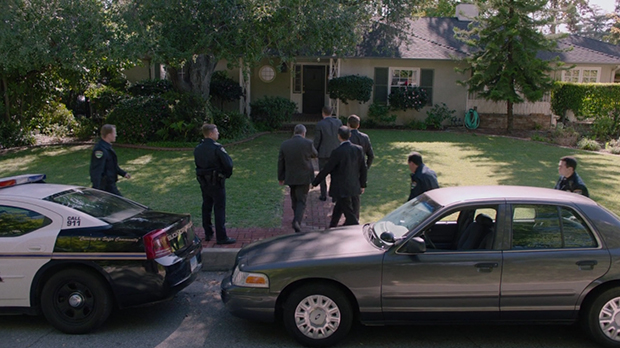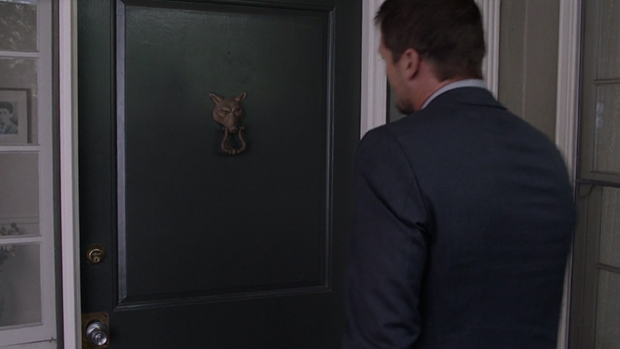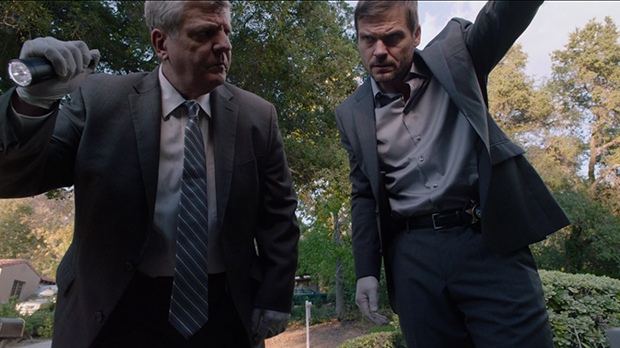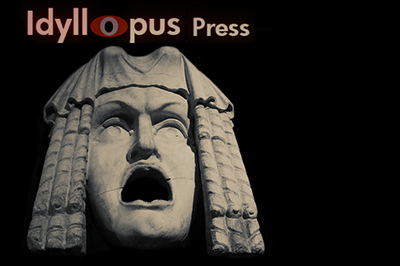TWIN PEAKS: THE RETURN

Go to Twin Peaks Table of Contents for a note on the analysis.
PART ONE
TOC and Supplemental Posts | Part 1 | Part 2 | Part 3 | Part 4 | Part 5 | Part 6 | Part 7 | Part 8 | Part 9 | Part 10 | Part 11 | Part 12 | Part 13 | Part 14 | Part 15 | Part 16 | Part 17 | Part 18 | Films Home
LINKS TO SECTIONS OF THE ANALYSIS ON THIS PAGE:
I'LL SEE YOU IN 25 YEARS, MEANWHILE
THE INTRO CREDITS - How to transition the faithful audience of the old Twin Peaks into the new world
IT IS IN OUR HOUSE NOW - Comparing the Red Room and the black-and-white room and Henry's apartment building in Eraserhead / Aural and silent worlds, communication without dialogue/ The gramophone and the ear in Blue Velvet / The job given the audience and its function / "It is in our house now" and Blue Velvet
DOCTOR JACOBY'S SHOVELS
A TOP SECRET JOB IN NEW YORK - The questions posed by the box / 33 Thomas Street as possible inspiration for the monolithic building / Boxes to boxes, a tie-in to the Jacoby scene / The "blown away" guy in the Maxwell Hi-Fidelity ad / The staging and similarities to Lost Highway and Blue Velvet / Our questions concerning the woman with the Z cups of coffee / The anchor of the promised visit / The bonsai and its link to spying in Twin Peaks and Blue Velvet
THE QUESTION OF THE SKUNK, AND BEN AND JERRY HORNE - From the mystery in New York to the return of the Hornes with the story of Mrs. Houseman of New York and the connection to "It's in our house" / The bad girl versus R-E-S-P-E-C-T for the woman / Faithlessness and "Hey Joe" / "In the meanwhile" for Ben and Jerry / Question posed
WHICH SHERIFF TRUMAN - A yellow rose, african violets and their possible relationship to the blue rose / Connecting the solitaire game's Jack of Hearts to One-Eyed Jacks / The problem of the two sheriff Trumans
MR. C VISITS BUELLA - Gender bending / Buella's waiting room / Lucy's demanding to know which two Trumans precdes the appearance of the doppelcoop / Otis as Senior Droolcup / Darya and her paper that links to the insurance salesman's business card
THE MISSING SECURITY GUARD - Linking the missing security guard to the scene at Buella's / Repeated action with a twist preceded by a left-right horizontal flip in orientation / The experiment
BUCKHORN, SOUTH DAKOTA AND THE MYSTERY OF BARNEY, HANK, HARVEY AND CHIP - A strong odor, but not a skunk - 1-1-6 / Punning the arm as arm-strong / The story of Marjorie Green and the keys / A yellow rose, dreamland, and an allusion to Blue Velvet
SOMETHING'S MISSING - My log has a message for you - A bit of history of Margaret and her log - Hawks' heritage
IDENTIFYING PRINCIPAL HASTINGS IN BUCKHORN
THE PRINCIPAL, BILL HASTINGS, TAKEN INTO CUSTODY
THE BOXES OF THE LAURA PALMER CASE FILES ARE BROUGHT OUT OF STORAGE - The story of Wally, who was of uncertain parentage in the original series / One-Eyed Jacks and Marlon Brando / Prospective many worlds theory only plausible explanation for Wally's birthdate / The peculiar Brennan family photo
HASTINGS QUESTIONED - Thursday night as an anchor for the viewer - Something wrong with her...
WE'RE COMING IN - Kafka and The Metamorphosis / Blue Velvet and the gold Volvo's trunk
LISTEN TO THE SOUNDS REDUX AND CREDITS
END NOTES
STAB AT A TIMELINE
I'LL SEE YOU IN 25 YEARS, MEANWHILE
(1) Open with the camera rushing over a zigzag floor of alternating shades of dark brown (perhaps brownish-black) and white, then richly vivid, voluminous red draperies. (2) Abruptly, the camera stops on a young Dale Cooper (Kyle McLachlan) seated in what has come to be popularly known as the Red Room, backed by red drapes. A sound of wind. (3) We are then shown Laura Palmer (Sheryl Lee) who greets Agent Cooper, reverse blinks her left eye and snaps her fingers. (4) Cooper considers her. (5) "I'll see you again in 25 years. Meanwhile...," Laura says in Lynchian reverse speech. She holds her hands up to form an inverted T formation that is both mysterious and mundane--mysterious in that it evokes the question of the "meanwhile", mundane in that it looks very much like hands posing to advertise a product. It is a pause and a framing.
The veteran viewer is knowledgable of Lynchian reverse speech in this minimalistic place called the Red Room, which is attractive in its strangeness, and approachable in its composing the seeming otherworldly within familiar forms. It is a space of meditation for the viewer, presenting itself originally as an opportunity for the 1990 - 1991 viewer to reconsider what they observed in the "real world" of Twin Peaks. Red Room entities both moved and spoke in a peculiar blend of backwards and forwards via the actors moving backwards, speaking phonetically their lines in reverse, and all this then being reversed to move forwards in time. The result was an uncanny disruption of the expected fluidity of cause and consequence.
THE INTRO CREDITS
At 1:03 begin to fade to black from Laura. At about 1:11, in the midst of the black, a ringing tone enters, like that of a meditation bowl, blending with the sound of the wind. (1) A circular rainbow effect is imprinted on cloud in an aerial view of a barely glimpsed forest. (2) Through clouds and mist, in a series of crossfades, we enter what is old and dear Twin Peaks territory to the returning viewer. We pass over a high ridge, (3) we view the old burned-out Packard mill, (4) the boldly red-striped hall of the Twin Peaks high school that Laura Palmer attended with her peers, (5) the girl running through the school quadrangle after learning the news of Laura's death, only we review her as if in memory, in slow motion, (6) and then zoom in on the high school's trophy case in which Homecoming Queen Laura's image is displayed, center stage, (7) moving to a close-up of the portrait, as the Twin Peaks theme begins to play.
Twin Peaks is a fantasy but fantasies have a way of being received as real, and Twin Peaks' places and characters have become quite substantial for many. Especially due the reviving of the footage of the girl who runs through the quadrangle, the veteran viewer may have the feeling of being returned to a real event. In the original series, the girl's running scream communicated to the students in Laura's home room that something horrible had happened, likely Laura's death. It had a comic touch to it, mixed with the air of the absurd, but was also a decidedly true moment that reflected the way news travels in schools, such as in a singular eruption, nudged by discrete caches of rumor that engender further rumor while also acting as confirmation before news is made public. With all, the awareness of Laura's death preceded any announcement of Laura's death. It was a happening that reverberated soundlessly, through an undertow of a kind of collective unconscious as experienced by bottled-up teens.
The credits are in two parts. We have just passed through the first that is composed of seven shots, four of which are from the original series (4, 5, 6, 7), while the others are new. The Packard Mill had been operative when the series began, but then had burned, so it is now but a ghostly shell.
Having revisited the mill, memories of the school, and the center-piece of Laura, we now enter the 2nd part of the credits as Laura's portrait, a photo taken against a blue studio backdrop, (8) crossfades to a near heavenly backdrop of turquoise blue water. This second half is all fresh interpretations of the old and familiar.
In a near overwhelming overhead shot, the camera passes over the fictitious White Tail Falls outside the Great Northern Lodge, showing how the twin cascades of water merge into one as they splash into the river below. This should be a powerful, symbolic image for the viewer, the water that is one, then parts, and returns to one channel. (9) We've a long crossfade to a new envisioning of the red curtains that undulate as flames, (10) then crossfade to what becomes a near frenzied whirl of the cascading zigzag floor. In the original series, the opening credit scenes had always resolved into the camera traveling along the undulating brown waters of the town's river, the dark columns of trees reflected in the waters in such a way that they were reminiscent of the folds of the drapes of the Red Room.
HOW TO TRANSITION THE FAITHFUL AUDIENCE OF THE OLD TWIN PEAKS INTO THE NEW WORLD
This is an opening for those who are already familiar with the series, returning us to famed elements that will resonate strongly. With the scene in the Red Room, Lynch/Frost open with Twin Peaks as it had been in episode twenty-nine (2.22), the last of the original two season run, when Laura had promised a meeting in twenty-five years. We are satisfied to see, leading in the The Return, these familiar faces of Cooper and Laura as they had been with the promise of that reunion, aware that at the end of the 1991 season Agent Dale Cooper had physically entered the Red Room but had not returned as himself. Something had gone wrong and a doppelganger had supplanted him. The last image the viewer had of Cooper, in the original series, was instead of his disconcerting doppelganger, laughing maniacally, blood flowing from his head after he had cracked it into a mirror, his reflection having revealed that he was also one with the evil entity, BOB, who had murdered Laura in the body of her father, Leland, who was not only a door to BOB but also complicit. The usurpation was a painful suspension and the cliffhanger of all cliffhangers--and if not a cliffhanger then it was tantamount to Cooper having become one of the damned, for what reason the audience would never know, and he lost forever to them. Even if one was not beholden to an antique sense of preservation of balance via just desserts judgment, in which good should be rewarded with good, that the spiritually-inclined, justice-seeking Cooper was so unexpectedly, abruptly estranged didn't provide resolution via the last rites compensation of tragedy. Cooper was as a Faust who had turned down a deal with the devil but at the last second was doomed by association.
In fact, Cooper had self-sacrificially agreed to give his soul over to his former mentor and nemesis, Windom Earle, if Earle released Cooper's girlfriend, Annie, who he had kidnapped. Earle had stabbed Cooper, recalling how he had stabbed him when Earle had killed his own wife, Caroline, who Cooper had been protecting and had become a lover of his in a storyline that took place before the beginning of the series, and after a vision of fire the action was undone, BOB intervening and saying this was not possible, that Earle could not take his soul. After BOB seemingly consumed Earle's spirit, as fire rising out of his head, it was subsequent this that we had our first glimpse of Coop's doppelganger, and Cooper then saw the doppelganger in the hall after being confronted by Leland's doppelganger who laughingly insisted he had killed no one. Cooper fled but was caught by the doppel before he could exit. His soul couldn't be claimed by Earle, but Cooper's heroic effort to save Annie was repaid with entrapment. There was no happy ending. Cooper was taken prisoner by the Red Room and his mad doppel released upon the world. The betrayal was heartbreaking, yet it also made ultimate sense in Lynchland.
The original series had vacillated between adventures in the small town of Twin Peaks, Washington, and forays into an otherworldly realm, the physical entrance for which was held to be at Glastonbury Grove, a circle of twelve sycamore trees enclosing a black well of seeming oil. FBI Agent Dale Cooper had arrived at Twin Peaks with the purpose of investigating the death of a teenager named Laura Palmer, and found that her killer was a composite of her physical father, Leland, and the evil paranormal entity named BOB, the supernatural and dream world blending and regularly intruding upon small town life. Cooper's investigations and mystical leanings had opened him to the Red Room where Laura Palmer, despite her death, appeared to linger on, as if she still lived in death because of her innocence. The Red Room, rather than striving for secrecy, actively imposed itself on the lives of certain characters, but was elusive in that it provided no real answers, no fundamental why, the viewers instead offered only vague ideas of a Black Lodge and a White Lodge operating behind the manifestation of the Red Room, and all that these ideas of the Black Lodge and White Lodge introduced through our congregate cultural histories of the conflict of fear and love, the negative and positive, and even the possibility of energies, often perceived of as polarizing opposites, being instead intertwined, yin and yang. At the end of the two seasons, whereas Cooper had previously entered the Red Room in dreams, he now entered it physically in order to save Annie, kidnapped there by Windom Earle, a former FBI colleague gone bad. What emerged was not Cooper but a doppelganger that had taken his place, and we have a trace of the uncanny that some twenty-five odd years later we are here again, as projected by Laura twenty-five odd years earlier.
What has happened in the meanwhile? We can only imagine Cooper in a limbo-like sitution, trapped within the zigzag bars of the Red Room.
To effect the transition from old to new, we are given that prophecy of a reunion, as it had originally appeared, and some shots in the credits that anchor The Return to the story of the death of Laura, but the iconic red drapes and falls are updated and thus we are gently distanced from what was and the possibility for the new opens.
IT IS IN OUR HOUSE NOW
(1) The credits have ended and faded into black. The music has ended and been replaced with a low rumble. At about 3:42 the camera pans briefly over a seeming disorganization of black-and-white and shades of gray to a shiny black pair of shoes, which is when we realize we are viewing the pattern of a carpet, and then up from the shoes to show an entity, dressed in a tux shirt and bow tie and smoking jacket, who in the original series was known as the Giant. "Agent Cooper," he says. (2) Cut to Agent Cooper in a second chair, who turns slightly to face this other individual who in the credits is given as ??????? rather than The Giant. (3) ??????? (Carel Struycken) instructs Cooper to "listen to the sounds", as he looks screen right. (4) We return to Agent Cooper, who slowly turns his head to look to screen left, in the direction of a fringed lampshade. We hear a critch. (5) We then see the large speaker horn of an old gramophone, which may remind of the iconic image of the black-and-white RCA dog seated before a similar horn listening to "His Master's Voice". In with the wind/rumbling sounds enter those that most closely resemble the clicks and scratches of insects. (6) A shot of Cooper considering the sounds. (7) Zoom in on the horn of the gramophone, a shot that reminds of Jeffrey, in Blue Velvet, discovering a severed ear in a field and the camera zooming in on its cochlea teaming with ants. (8) Return to ??????? as the clicks and scratches continue. He looks to the camera, towards Cooper. (9) Cooper looks to the camera, towards ???????.
(10) ??????? looks to Cooper.
???????: It is in our house now.
(11) Cooper looks at ???????, as if bewildered, then to the gramophone.
AGENT COOPER: It is?
(12)
???????: It all cannot be said aloud now.
(13) Cooper looks at ??????? but says nothing in response.
(14) ???????:
Remember 4-3-0.
(15) Cooper listens.
(16) ???????: Richard and Linda.
(17) Cooper, again, silent, only listening.
(18) ???????:
Two birds with one stone.
(19) Finally, Cooper responds.
AGENT COOPER: I understand.
(20)
???????: You are far away.
(21)
With a cracking static sound Cooper glitches out, he disappears in part then completely. Fade to black.
Cooper's appearance has immediately informed the viewer that indeed "in the meanwhile" much time had passed, and in their own lives as well if they watched Twin Peaks when it first aired. He is older, as are we. During his years in limbo, he has aged. Time has passed.
"It is in our house now" recalls Lost Highway. In that film, Fred and Renee discover that they are being voyeuristically filmed in their home. Later, Fred, meets a Mystery Man at a party who states he is not only at the party with him but is also right then at his house. He has Fred call his home phone and the Mystery Man answers though also standing next to him at the party. The Mystery Man seems to have to do with the voyeuristic videos Fred and his wife have been receiving. This voyeuristic filming takes us back to Blue Velvet and Jeffrey sneaking voyeuristically into Dorothy's home in order to watch her. The sensibility of the film is the pulling aside of a veneer of innocence and beauty to see what lurks underneath, that has been denied or gone unrecognized. In the screenplay of Blue Velvet, preserved in deleted footage, Aunt Barbara insists there are termites in the house, which Jeffrey at first discounts, but she finds and leaves two out for him. The scene was deleted as it wasn't needed, Aunt Barbara's termites were a metaphor for the secrets within the house and in society in general and how they were at work, secretly eating away at the house, unseen.
COMPARING THE RED ROOM AND THE BLACK-AND-WHITE ROOM AND HENRY'S APARTMENT BUILDING IN ERASERHEAD / AURAL AND SILENT WORLDS, COMMUNICATION WITHOUT DIALOGUE / THE GRAMOPHONE AND THE EAR IN BLUE VELVET / THE JOB GIVEN THE AUDIENCE AND ITS FUNCTION / IT IS IN OUR HOUSE
The waiting area of the Red Room is vivid and modern in feel despite vintage deco chairs.
Those who know Lynch's film, Eraserhead, will have recognized that the zigzag floor of the Red Room was the same pattern as the floor in the entry foyer to the apartment building in which the anxiety-ridden Henry Spencer lived. Cooper and ??????? are not the Red Room, which we immediately know by way of the carpet not being the same, which is even the first thing we are granted to see, yet though we are permitted to view very little of the room--a couple of upholstered chairs, a lamp with a fringed shade, textured drapes-- enough signals are resonant with the Red Room that we're aware it serves a similar function. This new room, which returns us to the black-and-white of Eraserhead, and which may symbolize in Twin Peaks the entanglements of the Black and White Lodges, projects the feel of an antique parlor, not only through the furnishings, but due ??????? wearing clothing that has a pre mid-20th century aesthetic--bowtie, tuxedo shirt, smoking jacket, and highly polished shoes. For all we know there could be a little nod to the 1960s television sitcom, The Addams Family, which had also a "giant" in tuxedo as butler, but that association never entered the original Twin Peaks series. This black-and-white space seems connected to the grand drama of silent film cinema as interpreted through the modern eye.
We are informed, Indeed, "It cannot be said aloud now".
The aural world is of great importance in Lynch's works, and ??????? has Cooper listen to a gramophone, so though "it cannot be said aloud now" we have other clues, such as the significance of non-dialogue sound.
In Blue Velvet, the discovery of a severed ear served to introduce the protagonist, Jeffrey, to an underground realm of mystery and crime. The real catalyst is Jeffrey's father's falling ill, which brings Jeffrey home, from college, to small town Lumberton, a prototype for Twin Peaks. After a visit with his father at the hospital, having experienced the shock of his father's condition and his inability now to speak, as Jeffry walks what is likely the familiar territory of his youth, he searches the ground in a field for a stone to throw and hit a metal barrel, but happens upon the funnel of the ear instead, its flesh crawling with ants. The criminal underground exposed via the discovery of that ear expresses a disorientation conjured by the catastrophic illness and also serves to buffer and distance Jeffrey from it, Jeffrey only shown visiting his father in the hospital a couple of times, and the remainder of the movie so seemingly unconcerned with the father and his illness that we almost forget what brought Jeffrey home. Even Jeffry's mother and "Aunt Barbara" (likely a great aunt) never bring up the father in conversation with Jeffry, nor do we have scenes of them expressing sadness or concern.
The violence of the criminal world repeatedly serves, for Lynch, as the frontier by which one crosses over into the spiritual underground.
The giant, identified as ??????? in The Return, had been a sympathetic, guiding entity in the original series, giving messages to Cooper of future events that served to confirm for Cooper, as they happened, his peculiar, otherworldly communications with the giant were real. The giant had first appeared when Cooper had been shot, informing him he was a friend and, "We want to help you." He told Cooper if several signs came true he would visit again. These signs were: a man in a smiling bag, the owls are not what they seem, without chemicals he points. He also said that Leo, a drug dealer, was locked in a hungry horse. Cooper had identified these things as coming true. However, these messages and later ones do not prevent evil from happening. After Laura Palmer's death, Maddy, her cousin (essentially a kind of double of Laura) comes to visit and offer succor to Laura's parents. When Maddy, too, is murdered by Leland/BOB, the giant appears on a stage and informs Cooper that "It's happening again", but the message is too late and too vague for the murder to be prevented. When Cooper and Annie discuss her entering the Miss Twin Peaks contest, the giant appears and expresses deep dismay, for the giant and the audience both know that Cooper's former mad-bad colleague, Windom Earle, has plans to use the contest for his own diabolical ends against Cooper, but this message from the giant was again not understood and not heeded.
We recognize ??????? from the original series. We feel he is one and the same entity and thus likely helpful. But if his name is now ???????, rather than him being identified as the Giant, we can't be sure of this. Or can we have confidence in his nonthreatening demeanor? Cooper has been told to remember several things, but whether these are future or past is ambiguous. Is he to remember events that happened in the "meanwhile"? Or is he to pay attention and look for these things as they happen, yet to come. We imagine they are yet to happen though he is told to "remember" them. Certainly, for the audience, these are future things. The messages, for the viewer, serve as a grab bag of items to hold onto in the forthcoming episodes, things for which to watch as the action unfolds, the search for these things itself operating as an anchor to give reassurance when the viewer is confused over intention and meaning--they have their own job and their job is to find these things. It is not only Cooper's order to fulfill, the process of keeping watch and remembering, it is that of the audience's. They are to find 4-3-0, they are to find Richard and Linda, they are to consider two birds with one stone, they are to keep the sounds in mind and listen for them. That job mandates that the viewer pay closer attention than they might usually, knowledgable that they are supposed to do so, and thus enlarge their experience in this manner. They are also attuned to the fact they must pay heed to the sound track. This is art and not just simple entertainment.
The viewer was given much the same encouragement to pay attention to and question detail in Fire Walk With me.
When Chet Desmond arrived in Oregon to investigate the death of Theresa Banks, Gordon Cole introduced him to a woman, Lil, who performed a little play for them. Sam Stanley, another agent, later explained for Chet the absurd particulars of the play and what her movements meant, as well as her clothing. The explanation for the signs was such that no viewer could have ever divined them. That is because the divination is less important than the learning to pay attention to one's world and not take it for granted.
We have also been warned that something is in "our house now". As an author and artist, I take this as being also a suggestion that whatever "it" may be is in the homes of the viewers, by the fact of their participation as viewers. For the viewer, that "it" could possibly be nothing more than the primer of learning to pay attention to one's own world.
DOCTOR JACOBY'S SHOVELS
(1) 6:10. The mountains of Twin Peaks with the shadows of clouds moving over their multiple stony faces and forests. We hear birds. (2) We are shown, in the sun-dappled woods, a place with which we are unfamiliar, a ramshackle trailer with an exterior work area partly covered by canvas strung to the trees. We hear wind and then the rumbling of an engine. (3) A red pickup truck, carrying two large cardboard boxes, backs into the driveway of the trailer home. (4) "Joe" (Joseph M. Auger), the delivery driver, calls out "Hey, Doc!" to an elder man who who exits his trailer home, an Alpenrose plastic crate beside his stoop. The elder man, in work-grunged overalls and a plaid shirt, calls out in return, "Hey, Joe!".
The elder man wears sunshades as he exits, which he takes off, revealing glasses with a red lens over his right eye and a blue for his left. It is the familiar face of Dr. Lawrence Jacoby who was a psychiatrist in the original series.
As Joe unloads the boxes, he calls out, "How's it going, Doc?", to which Jacoby replies, "As good as ever.". (5) We have a distant shot, through the trees, as Joe cuts open a box and we see that what he is delivering are shovels. We are given time to listen to the rustling of wind through the trees and the many animal and insect sounds of nature. (6) A closer shot of Joe and Jacoby as Joe continues to remove shovels from the top box, discarding the plastic that covers the heads of each. (7) Return to the distant shot as of 6, Joe asking Jacoby, "You going to need any help, Doc?" Jacoby replies that, "Hey, y'know, thanks but no thanks. I prefer to work alone." Fade to black.
JACOBY'S GLASSES AND HIS "MEANWHILE" METAMORPHOSIS / OUR QUESTIONS / THE UNWRAPPING OF THE PLASTIC FROM THE SHOVELS AND ITS MEANING / HEY JOE
Why does Jacoby wear sunglasses only to take them off outside? Because the character has changed enough, over twenty-five years, as well his environment, that it is wanted that we briefly not recognize him and be surprised by his metamorphosis. In his red and blue glasses, however, we immediately know him as Dr. Lawrence Jacoby (Russ Tamblyn). If one is acquainted with the book, The Secret History of Twin Peaks then one is also aware that Jacoby believes the tints of his red and blue glasses have an effect on the left and right hemispheres of the brain, bringing them into balance so that reality can be better observed. One red lens and one blue lens are also used in glasses that give three-dimensional perception for properly prepared images.
It's somewhat unexpected that Jacoby would be among the first of old familiar faces in The Return. But then, in the original series, Jacoby dealt with matters of the mind and spirit, the outsider psychiatrist who operated as the eccentric, counter-culture "shaman", so Jacoby seems an appropriate person to transition us from the otherworldly opening to the real world. Jacoby came to be, in the original series, a reassuring presence with a critical flaw that made him sometimes suspicious in the first episodes, for he had erred in falling in love with Laura, who was a patient. As he was a character who was largely peripheral to the stories of others, he was one with whom we were left no cliffhangers at the end of the two seasons. In The Secret History of Twin Peaks we learn that in the "meanwhile" he lost his license to practice psychiatry, having been found unethical in his treatment of Laura Palmer. Due the loss of the license--which would mean a loss of income, profession, identity--this is a man whose life, these twenty-five years, has been dramatically affected by the consequences of having had Laura as a patient. As seemingly revealed by his interaction with Joe, he is now perhaps a largely solitary soul. This is the impression we are given--that he likes solitude and his style of living has downgraded substantially.
The question posed for the viewer is what will he do with these shovels? But, we also have the removal of the plastic from the heads of the shovels that may merit consideration. The reason is because of how the pilot of Twin Peaks opened. There was a brief scene of Josie Packard gazing at her reflection in a mirror, then Pete Martel saying goodbye to his wife, Catherine, as he went out to fish. Immediately after this, Pete had found, beside a monstrous beached trunk of a redwood tree, the body of Laura Palmer wrapped in plastic. As each of the shovels are removed from plastic, the milky film unsheathed from their heads, one might think of that plastic film that shrouded Laura, and of her being turned over and the plastic turned down to reveal her face.
Lynch/Frost had highlighted attention to the aural aspects of The Return. Because Dr. Jacoby is of a certain generation, even though we don't hear the track, I offer for your consideration Jimi Hendrix's version of, "Hey, Joe".
The lyrics concern a man who found his wife had been cheating on him, so shot her, and is on his way to Mexico. This doesn't apply to anything in Jacoby's life, but there is a lot of such cheating in Twin Peaks, and after Maddy's death, James Hurley had left with a plan on going down to Mexico.
Finishing this section, I would like to point out again the Alpenrose dairy crate. We may be reminded of the "Blue Rose" supernatural cases the FBI was investigating in the original series. Alpenrose is not a blue rose, it is instead a mountain rose, sometimes called also a snow-rose, which might bring to mind icy (blue) glaciers.
AFTER 10:00 P.M. IN NEW YORK, A TOP SECRET JOB
THE QUESTIONS POSED BY THE BOX / 33 THOMAS STREET AS POSSIBLE INSPIRATION FOR THE MONOLITHIC BUILDING / BOXES TO BOXES, A TIE-IN TO THE JACOBY SCENE / THE "BLOWN-AWAY" GUY IN THE MAXWELL HI-FIDELITY AD / THE STAGING AND LOST HIGHWAY AND BLUE VELVET / OUR QUESTIONS CONCERNING THE WOMAN WITH THE Z CUPS OF COFFEE / THE ANCHOR OF THE PROMISED VISIT / THE BONSAI AND ITS LINK TO SPYING IN TWIN PEAKS AND BLUE VELVET
(1) 8:30. An abrupt change to New York. Night. The original Twin Peaks never took us to NEW YORK CITY, so the many jeweled lights of the city and its human-made mountains are a bit of a surprise. They are also not that big a surprise as we must expect The Return to likely introduce new story lines and even possibly new places. We see a distant establishing shot that shows the Chrysler Building. (2) Another aerial shot takes us closer in but without readily identifiable buildings. Due the slow panning in these shots, that sense of motion, and the sounds of traffic, we may not notice that there is no movement in the traffic on the streets in either shot, instead the shots feel sparkling alive. (3) From ground view we then have a shot looking up at a red-brick monolith of a building with few windows, which is where we are heading. The building stands out because it has no windows, is oblique and immediately mysterious. It doesn't want us to know what's inside, whereas the interiors of the skyscrapers surrounding are exposed. One may be reminded of the building at 33 Thomas Street in New York, famous for having no windows, given by Wikipedia as "a telephone exchange or wire center building which contained three major 4ESS switches used for interexchange (long distance) telephony, two owned by AT&T and one formerly owned by Verizon...reportedly home to a National Security Agency surveillance facility named TITANPOINTE." An Intercept article states the FBI "occupies the entire 23rd floor of 26 Federal Plaza, seen...behind 33 Thomas Street." 33 Thomas Street, without windows, is mysterious. Lynch/Frost may have drawn upon this real life mystery for their building.
(4) The interior immediately presents a new mystery. We are shown a circular window enclosed in a glass box. A low hum accompanies. (5) We are shown a close-up of a young man (Benjamin Rosenfield) likely watching the box. (6) Now we have an establishing shot of the window within the glass box. The portal of the window, within a black arch encasement, may call to mind a camera or a projector. The glass box is structured so that a large X occupies the ceiling. Bright lights shine on the box and cameras are set about it.
We wonder what is this glass box and why does it have this window? Why is the glass box being meticulously recorded from several angles? We wonder who is this man who is watching it.
(7) As in shot 5, we are shown again the young man passively watching the box. (8) We have then a distant side shot that establishes the relationship of the box and the man to the cavernous room.
The young man sits on a stage that theatrically presents the setting of a living room. This is opposite the raised "stage" of the glass box.
We see, on either side, cardboard boxes at opposite ends of the room, some of these boxes closed and some of these opened and scattered pellmell.
As far as constructing a visual bridge between this and the prior scene with Jacoby, the cardboard boxes may tie back to the two long cardboard boxes he had received. As we go along, we will find that Lynch and Frost not infrequently connect many scenes in such a manner.
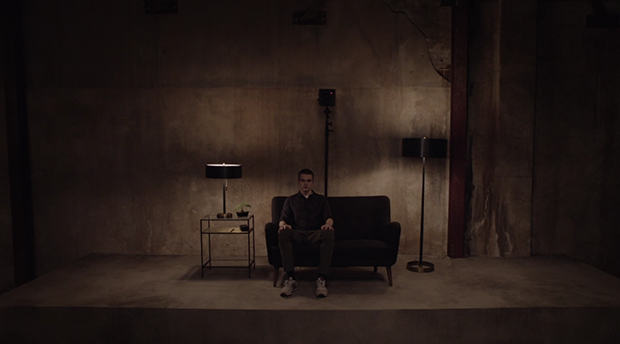
The stage holding the living room
The dark tones, the framing, the vignetting with shadows, and spare modernity seem to evoke in this space the Lost Highway home of Fred, a character who may or may not have murdered his wife. We have no idea of the identity of this individual seated on a lone sofa facing the glass box, but there is something in his face that may remind of Adam, the director in Mulholland Drive.
The relationship of the man to the glass box may also remind of the "blown away guy" in the Maxell hi-fidelity ad from about 1979-1980. (Looking ahead, considering what happens in this room, there's good reason to make that association.)
(9) A close-up of the lens of one of the cameras focused on the box. In the unfocused distance are the lamps of two ceiling lights against darkness. (10) Another close-up of a camera. This time we see a red light in the upper right corner of the camera's box above the lens. In the distance are the unfocused lamps of three ceiling lights, some cardboard boxes on the floor, and an unfocused blue light to the left. (11) We are shown again the "lens" window within the glass box. (12) Then a medium-distant shot of the man on the sofa, as if we are watching him from the box itself. We wonder, who is he, and what is going on with this glass box? The setup is obviously monied, a profound expense having gone into it. We might consider that the young man is the one responsible, but his sneakers might make us also reconsider that assessment. Are they the shoes of the person who woud be responsible for this room? (13) Again we are shown the box from the front, the lights and cameras to the side of it, as well as a ladder that is cropped by the framing so it resembles a black sawhorse.
What is most significant is the sense of staging, and that we are looking at two elevated stagings facing one another. The glass box is that which is being watched and the man on his sofa evokes the audience setting of a minimalist living room, but such care is given to the elements in that seating area--the sofa and its side table, the lamps, the bonsai--that it certainly is discerned as a stage, from front and side views, while also being an audience platform. It is here where Lynch will first powerfully break the fourth wall in The Return, and thus also takes us back to Jeffrey, in Blue Velvet, when he hides in Dorothy Vallence's closet, watching her home as a stage, an apartment with only a couple of small, observed windows that are largely non-functional and only there so the viewer won't say, "Oh, look, no windows?", the walls darkly painted, the furnishings spare and stage-like. Dorothy's apartment, as well as the exterior corridor leading to it, with its lighting, its sconces, the deco revival touches, had the air of some art house movie theaters of the time so that one might have the feeling of watching a movie theater from a movie theater, even further linking Jeffry to the viewer. When Dorothy discovered Jeffrey in her closet, she ordered him out of it into the action, much as with the Maxell ad in which the home listener is promised not only an experience similar to listening live, but even more so, the power such that they will be blown away.
(14) We return to a close-up of the young man. A buzzer attracts his notice. A woman's voice, on an intercom, informs him that the memory card in "Camera 3" needs to be changed. (15) A distant 3/4 view of him rising, taking a box from the side table, getting the ladder and climbing it to a right camera. We hear something distantly ringing as he changes the card. He checks his watch. We see that the rear of the lights is a red that seems striped with black, perhaps shadows from a corrugated surface, and may remind of the lush folds of the curtains of the Red Room. (16) He has gone to a large case that he opens. (17) He slips the SD card in with a bank of others. (18) He closes the case and locks its bright red handle in place. (19) A 3/4 view of him as he returns to the sofa. We had perhaps only once heard the ringing after shot 15, but we hear it yet again in this shot. It sounds like a phone but it likely is not and we don't know its source.
What is curious about the man is the precision of his movements, their economy. His isn't a military bearing, but we see a like precision in military displays, the enunciation of the shift of a rifle from the left shoulder to the right, the deliberate and even ritualistic gestures that compose the moves. He affects the same deliberation.
(20) A close-up shot of him again seated on the sofa, facing the box. We hear an elevator. (21) A shot of the glass box. (22) Another side-shot of the room. A buzzer sounds. A man comes on the intercom and announces, "Delivery." He dismounts the "stage" and goes to the far end of the room. We hear him punching in a code to exit the area. As he must punch a code to exit this area to an outer chamber, we are given the impression that this activity of watching and recording the glass box is highly secret, but we already knew from the building's lack of windows that this is secret.
(23) A medium close-up shot of a taciturn security guard (Michael Bisping) who scarcely moves. (24) From beyond the security guard's left shoulder, we view a a young woman (Madeline Zima) who is waiting with two cups of take-out coffee, those white cups each marked with a large black Z and a period, and so we may be reminded of the zig-zag floor of the Red Room. (25) The security guard again. We hear a metal door sliding open, and he looks toward the sound.
(26) From beyond the guard's left shoulder again, we see the young woman, and now the young man entering through a door into the room. Both the young man and young woman are dressed in muted dark tones that blend with the muted sepia darkness of the area.
SAM COLBY: Hey, Tracey.
TRACEY BARBERATO: Hey.
SAM: You didn't have to bring it yourself.
(27) Medium close-up of the young woman from beyond Sam's right shoulder. SAM: Aren't you supposed to be working?
TRACEY BARBERATO: No, I got off at ten. I brought two. Can I join you?
(28) Medium close-up of Sam from beyond Tracey's left shoulder. He glances to the side, at the security guard.
SAM: Damn. Tracey, I'm sorry but no one can come in here.
(29) Shot of Tracey from beyond Sam's right shoulder. SAM:
How much do I owe ya?
TRACEY: Oh, no, no, I got 'em for free.
(30) Shot of Sam.
(31) Shot of Tracey. TRACEY:
I can't come in? She glances at the security guard.
(32) From between Sam and Tracey, a shot of the security guard at his desk. SECURITY GUARD: That's right.
The guard, too, is a studied, economical presence. He betrays no personality, whereas Sam has relaxed slightly in Tracey's presence but still behaves with perhaps the acute awareness of being observed.
(33) Close-up of Tracey. TRACEY: Shoot. She laughs.
(34) Shot of Sam. SAM: Top secret.
(35) Close-up of Tracey glancing to the security guard. TRACEY: Ooh. Now I'm so curious you're driving me crazy.
(36) As with shot 32, the security guard from between the pair. He doesn't react.
(37) Back to a close-up of Tracey.
SAM: In fact, I got to go back in.
(38) Close-up of Sam. SAM: I'll stop by on my way in tomorrow if I can. He nods.
(39) Close-up of Tracey. TRACEY: OK. Or, if I miss you, I can come back tomorrow night and bring coffees, the same time.
(40) Close-up of Sam. SAM: Thanks, Tracey.
(41) Sam moves to take the coffees. TRACEY: You can have 'em both.
(42) Sam from beyond Tracey's left shoulder. SAM: Thanks, Tracey. He moves away.
(43) Close-up of Tracey. (44) A shot of Sam from beyond Tracey's left shoulder, he at the door, punching in the security code, she watching. (45) A shot of Tracey from over Sam's shoulder, she closely watching, even noticeably leaning in to get a better view. (46) A shot of Sam from beyond Tracey's shoulder. He senses her watching and turns to look at her. (47) Tracey from beyond Sam's shoulder.
(48) Sam from beyond Tracey's shoulder, he remarking on her watching him. SAM: You're a bad girl, Tracey.
(49) Tracey from beyond Sam's shoulder. TRACEY: Try me. She smiles invitingly.
(50) Sam from beyond Tracey's shoulder. He finishes punching in the code. The door opens and he enters. (51) A shot of Tracey watching as he enters. (52) Exiting, Sam glances back at Tracey. (53) A close-up of Tracey as we hear the door slide shut. She glances back at the security guard. (54) Close-up of the stone-faced security guard who gives no sign of paying any attention. (55) Shot from beyond the guard's shoulder of Tracey entering the elevator. (56) A medium close-up of Tracey in the elevator, going back down, a buzzer sounding twice. (57) A side shot of the glass box room, Sam entering and crossing over to the "stage" with his coffees. (58) A close-up of Sam sitting on the sofa. (59) The glass box. (60) Sam takes an appreciative sip of his coffee.
The woman is there to deliver coffee. She wants to see where Sam works, but he refuses as it is secret. She gives him the coffee, then tries to look over his shoulder as he punches in the security code to return to the room with glass box. The conversation is a rather peculiar one, stilted. Sam has seemed surprised to see the woman delivering the coffee herself, and Tracey's eagerness to see where Sam works begins to feel so awkward that even before Sam notes her looking over his shoulder, as he punches in his security code, the viewer may wonder if she is there to gather information, but one also questions how she would come to be a spy if she is a barista. We are even more convinced, with Tracey's straining to see over Sam's shoulder, that she could very possibly be spying.
A date is set for them to meet again. The next day. We expect to see these two again. We have another anchor.
Lynch has used mysterious boxes before. In Mulholland Drive there is a curious blue box. When an individual eventually opens it, the box is shown to be empty. The individual holding the box disappears and the box falls to the floor.
A sub-minor detail that my attention keeps returning to is the miniature bonsai. In the episode "On the Wings of Love", in the original series, a bonsai had been delivered to Sheriff Harry Truman with the message it was from Josie Packard, a former lover of his who died after being revealed as a murderer. Later, those at the sheriff's department discover the tree was from Windom Earle and had a listening device in it by which he spied on them.
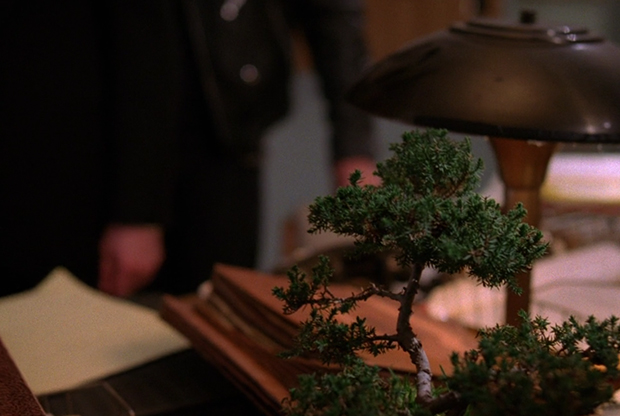
Bonsai in the original series
Nature has ears and listens. In the case of the bonsai tree it was "bugged". Earle was spying. We are reminded of Jeffrey in Blue Velvet and how he pretends to be the exterminator, the "bug man", in order to gain entrance to Dorothy's apartment and spy on her. As the pretend exterminator, his plan was to open a window when she was distracted and return by means of it later. However, this plan was interrupted and he instead stole her keys. Which was how it had to be as Dorothy's window was an area enclosed on all sides by halls on the non-existent seventh floor of a building and so actually had no functioning windows. We may reflect on this fact and thus a certain similarity to this building that also has no windows but for the mysterious camera-like portal.
THE QUESTION OF THE SKUNK, AND BEN AND JERRY HORNE
FROM THE MYSTERY OF NEW YORK TO THE RETURN OF THE HORNES WITH MRS. HOUSEMAN (IT'S IN OUR HOUSE NOW) OF NEW YORK
Jacoby was the first Twin Peaks resident to return. Now enter the Horne brothers and their familiar lodge that served as a centerpoint for many of the story lines of Twin Peaks, Cooper having stayed at the lodge during his investigation, and the Horne family contributing, for plot fodder, not only brothers Ben and Jerry, but Ben's daughter Audrey, his son Johnny, and the businesses owned by the Hornes--the lodge, the One-Eyed Jacks brothel/casino, and the department store.
(1) 15:39. A view of The Great Northern Lodge atop the falls, the soft pinkish light of morning shining on the building. (2) Cut to Ben's office, his secretary Beverly Paige (Ashley Judd) entering. He says, "Beverly, tell Mrs. Houseman that we will refund two nights of her stay..." (3) Cut to a side shot of the pair, Ben continuing, "...but not the whole week. She and her New York friends..." (4) Ben from beyond Beverly's right shoulder, he finishing, "...keep our spa running." Beverly says, "Oh, good." (5) Beverly from beyond Ben's left shoulder as she then asks, "How did the skunk get in her room?", which lets us know why Mrs. Houseman wanted a refund. Ben (Richard Beymer) asks, "What's that?", as if he had not heard her. And she must repeat, "Uh, the skunk, how did it get into her room?" Ben insists, "Oh, no, no, no, no, it wasn't even close to her room." (6) Ben from beyond Beverly's right. Beverly seems to believe that the skunk was in the room, but Ben argues, "The skunk was on the whole other side of the hotel. It was..."
At that moment we hear Jerry (David Patrick Kelly) call out, "I am here, brother Ben!" (7) A view of Beverly from beyond Ben's left shoulder, he tensing up. We hear Jerry stomping and laughing. (8) A more distant 3/4 view of Ben's desk, Beverly to the left, as Jerry stomps in through a double door on the right. He enters with a plate of food behind his back, which he then displays, cackling, "Sweet and sour. Salty, crunchy." (9) Ben and Jerry viewed from beyond Beverly's right. We now realize Beverly is new, Ben introducing Jerry to her. "Beverly, my brother, Jerry." (10) Beverly from Ben's left as she greets Jerry. "Hi, nice to meet you." (11) Return to the view of Jerry and Ben from beyond Beverly's right. Ben says, "So, get back to Mrs. Houseman as we discussed and I'll get back to you later." (12) We've cut back to a view of Beverly from beyond Ben's left as she says, "Okay, sure thing," and goes to the office's main double door. (13) Drop back to a more distant shot as Beverly exits. Jerry takes a seat, swinging his legs over the chair's armrest. With Beverly now out of the room, he and Ben discuss whether Beverly is a girl or a woman, and how Jerry's new cannabis business helps to support the hotel.
JERRY: Is that the new girl? Or should I say woman? A woman like that you can't call a girl.
BEN: Beverly, yes.
JERRY: Are you banging her yet?
BEN: Oh, Jerry.
(14) A medium close-up of the exasperated Ben. BEN: R-E-S-P-E-C-T. Respect. She's a beautiful soul (pause) and she's married.
(15) Ben lights his cigar as we drop back to a view of the two brothers.
JERRY: That never stopped you before. Sock it to me. Sock it to me. Sock it to me. Sock it to me.
(16) We've switched to Jerry and Ben viewed from beyond where Beverly had been positioned. BEN: Jerry, what else do you have on your mind.
JERRY: Swimming in my mind at this time, literally, is my new hydroponic indica-sativa hybrid, a touch of the mythic AK-47, by way of the Amsterdam Express. It's baked into this banana bread and infused in this potent spreadable jam that's ideal for creative sojourns of a solitary nature. Wheels up.
(17) As with shot 8, a distant 3/4 view of Ben's desk, from behind the seated Jerry who crunches into his banana bread. BEN: Jerry, a prophet is without honor who eats his own profits.
JERRY: R&D, brother Ben. (18) Cut back to the view of the room from beyond Ben's desk, facing the window from the main door. JERRY: It puts me in a groove, and where it stops, nobody knows.
BEN: Thank god you are no longer in the hotel business.
JERRY: Where have you been, Ben? Yeah, my new legally sanctioned business is tripling our revenue.
BEN (after a long pause, pointing his finger, as Jerry crunches into his bread): Is that mother's hat?
THE PROBLEM OF THE SKUNK / IN THE HOUSE / THE BAD GIRL VERSUS R-E-S-P-E-C-T FOR THE WOMAN / FAITHFULNESS AND "HEY JOE" / IN THE "MEANWHILE" FOR BEN AND JERRY / QUESTION POSED
Is Ben lying about the skunk? How about Jerry? Had he been smoking Super Skunk weed in one of the corridors hidden in the walls of the lodge, such as Audrey used to haunt and smoke cigarettes in, and the odor permeated Houseman's room? With Cooper stuck in limbo land and his doppelganger on the loose--the original series having advanced the idea of there being the two supernatural lodges, a Black Lodge and a White Lodge, a gateway to them being the Red Room where we have the alternating light and dark stripes in the zigzag floor--is it possible that Mrs. Houseman saw the black-and-white skunk in her room, and that Ben's assertion is also correct, that the skunk was on the other side of the hotel? Hadn't we observed, with Cooper and ???????, that though he appeared to be present he was actually "far away"? Isn't just about anything possible in the land of Twin Peaks?
??????? had told Cooper that "It is in our house now." We may be reminded of this due Mrs. House-man having found a skunk in her room. There seems some intentional word play, just as Ben toyed with his prophet-profit pun. We could use wordplay to connect Horne with the gramophone horn.
A link with the previous New York scene is that now we have a woman from New York who is keeping the "spa" afloat in Twin Peaks, though Jerry asserts his legal drug business is responsible, which must sting Ben some.
Another link with the New York scene is that Sam had called Tracey a "bad girl", and the conversation between Jerry and Ben opens with Jerry supposing he shouldn't call Beverly a girl, not "with a woman like that", then Ben responding with a line from Aretha Franklin's song, "Respect", when Jerry asks if he's banging her.
Ben and Jerry, twenty-five years earlier, were a near frenetic, sometimes frantic, combination of business meets pleasure and trouble, but Ben attempted to turn over a new leaf after his daughter Audrey was abducted, drugged, and held at a casino/brothel that he secretly owned, which was followed by an emotional breakdown on his part. How successful has he been at his self-reformation? From what Jerry has said, it sounds as if Ben has at least had no scruples against sleeping with employees in the "meanwhile", which is a touchy area as far as best business practices, considering the power differential. But Beverly is different. She's married. This wouldn't have mattered to the old Ben. Marital faithfulness, or lack of it, was a source of considerable drama in the old Twin Peaks. Ben wasn't the only who was unfaithful. Shelly, the young waitress, sleeping with Bobby Briggs, was unfaithful to her husband. Leo Johnson, but her husband was also unfaithful, sleeping all around. Bobby, who was Laura Palmer's boyfriend, was unfaithful to her, sleeping with Shelly. Laura was unfaithful to Bobby, sleeping with James Hurley, a biker, and leading a double-life as a prostitute. Ed Hurley, the owner of the gas station, was emotionally unfaithful to his wife, Nadine, pining for Norma, owner of the town's best diner. Norma, in love with Ed, was emotionally unfaithful to her husband, Hank, who was in prison and then came home and was unfaithful to her. Nadine was eventually unfaithful to Ed, though she was mentally out to lunch at the time, believing she was a high school student again. Leland Palmer was unfaithful to his wife, Sarah, hiring prostitutes when he wasn't raping their daughter. Catherine Packard was unfaithful to her husband, Pete Martell, she sleeping with Ben, who was sleeping with whomever he wanted, including Laura. With Jacoby's earlier scene, perhaps there had been indeed an allusion to the song "Hey Joe", in which a a man shoots a faithless woman and runs off to Mexico. Now, to Jerry's surprise, Ben insists he can't pursue Beverly because she is married.

Ben Horne's Office in Original Series
Ben Horne's office has changed, but it's a new season, twenty-five years removed, and all we need do is note that it has, the new office retaining so much of the sensibility of the older one that, except for mentioning that it is no longer sunken, I'll refrain from delving into how it's been altered.
Jerry, too, has changed in some respects, as has Jacoby, but Ben has not changed in physical presentation. The Jacoby who was an eccentric but well-kept dresser in the original series has disappeared, replaced with a man who wears dirty overalls. Jerry, in the original series, was probably the most fashionably dressed man in Twin Peaks, his persona that of the worldly traveler interested in hedonistic pleasure, food, sex, and attentive to appearances. He is still interested in food, and drugs, but now is also comfortably attired in the persona of the aged hippy, scraggly-bearded drug aficionado, which is in full keeping with his new profession as a psychotropic herbalist. He was ambitious and still is, such a success that he is helping to support Ben's struggling hotel business.
Doesn't it seem bad practice, for a struggling business, that Ben would refuse to refund the whole week for Mrs. Houseman if she is as critical to the spa as he says she is?
The question we are left with is posed by Ben in his fit of jealous pique over Jerry keeping his business afloat. "Is that mother's hat?" he demands.
And we realize, with all the trivia we have on some of the characters of Twin Peaks, we know nothing about the mother of Jerry and Ben. We know their father was J. J. Horne. We know the names and a few facts about J. J. Horne's parents. Yet we know nothing about the woman who was married to J. J., not even her name. All that we know is that this hat Jerry wears may or may not have been her knit hat. Whether or not it is mother's hat, we are left to wonder if Ben might be jealous, as if his question shows that Jerry may have been the favorite son. We are also left to wonder if Jerry would don mother's hat.
In Episode 20 of Season 2, an elder women, in a similar knit hat, but in brown and beige colors, was eating pie at the diner when her right arm began to shake uncontrollably. Cooper and Pete also experienced the same shaking. The feeling was had of the Other Side growing stronger and affecting the citizens of Twin Peaks.
WHICH SHERIFF TRUMAN
A YELLOW ROSE, AFRICAN VIOLETS, AND THEIR POSSIBLE RELATIONSHIP TO THE BLUE ROSE / CONNECTING THE SOLITAIRE'S JACK OF HEARTS TO ONE-EYED JACKS / THE PROBLEM OF THE TWO SHERIFF TRUMANS
(1) About 18:24. Sunlight, soft and brilliant, radiates through the trees above the Twin Peaks Sheriff's Department. Be still our beating hearts! The Sheriff's department had, of course, been another centerpoint for storylines in the original Twin Peaks, and next we return to it and the beloved Lucy.
(2) Lucy Brennon (Kimmy Robertson) appears to be putting a small yellow rose into a pencil/pen caddy, and perhaps has been playing Solitaire as she has spread across her desk a deck of cards with a Jack of Hearts as one of the cards more prominently exposed. The Jack of Hearts may be a subtle tie-in to the previous scene, for One-Eyed Jacks was the name of the brothel/casino that Ben Horne owned. Also, Jerry had spoken of the banana bread and jam as being conducive for creative sojourns of a "solitary" nature.
(3) A view from behind Lucy's left shoulder as a portly, balding man in a suit enters the front door and says to her, "Hello, I'd like to see Sheriff Truman." Lucy asks, confusing him, "Which one?" (4) A view of Lucy from the man's right shoulder, she repeating to him, "Which one?"
(5) View of the man from Lucy's left shoulder. INSURANCE SALESMAN: Sheriff Truman isn't here?
LUCY: Well, do you know which one? It could make a difference.
INSURANCE SALESMAN: Uh, no, ma'am.
(6) View of Lucy from the salesman's right shoulder. LUCY: One is sick, and the other one is fishing.
(7) View of the salesman from Lucy's left. INSURANCE SALESMAN: Uh...
(8) Medium close-up of Lucy so that we have a view of a locket, perhaps a watch, she wears around her neck. LUCY: It could make a difference.
(9) View of the salesman from Lucy's left. INSURANCE SALESMAN: It's about insurance.
(10) Medium close-up of Lucy again. LUCY: I'm not sure I will be able to help you.
(11) A view of the man from Lucy's left shoulder. We have returned to the beginning of the conversation again and repeat it. INSURANCE SALESMAN: I'd like to see Sheriff Truman. (12) Medium close-up of Lucy who now in response simply stares in confusion. (13) The salesman from Lucy's left as he takes out and hands her a card. INSURANCE SALEMAN: I'll leave my card and call in another day.
LUCY: Thank you. I'll keep the card, but unless... The man exiting, Lucy looks in bewilderment, as if wondering to where he's gone. (14) Medium close-up of Lucy glancing about the waiting room to ensure the man is gone, then putting away the card.
We are given opportunity enough to see that Lucy has placed a yellow rose in the pencil cubby, which would seem to have significance through Laura Palmer's case being one of the mysterious Blue Rose cases investigated by the FBI. A yellow rose is typically symbolic of friendship. But we do have also an allusion to the color of the Blue Rose nearby, in the African Violets. The name of the flower is Saintpaulia ionatha. The Saintpaulia is to commemorate the discoverer of this flower that is not actually a violet. The etymology of ionatha is a combination of ion, meaning blue-violet, and athas, meaning flower. A blue rose thus is alluded to through the yellow flower's proximity to the "blue-violet flower".
Though retaining the same flavor, the receptionist area has changed slightly from the old series. So has Lucy, though she still is the receptionist/secretary, and though she is still associated with games, in the old series depicted also with chess and Scrabble, she sometimes tasked with using games to assist in investigations. Lucy was always a little fragmented, perpetually and delightfully confused, but she wasn't dysfunctional. In this analysis, I'm trying to keep "in time" with The Return episodes as they unfold, to concentrate on making past-oriented associations rather than augment with revelations on what occurs in later episodes, but I will say that Lucy, as suggested here, has become something of a puzzle in the exaggerated nature of her confusion. Yes, it is played for laughs, but one begins already to get the feeling that her cryptic and now even painfully dysfunctional nature is more than a matter of amusement for the audience, and has attained the level of Lucy as the simple-minded fool as a kind of spiritual guide. Via her perspective she seems to be unconsciously communicating messages that give the viewer clues as to how to view the Twin Peaks world. In the original episodes, the wide-eyed Lucy may very well have been less obtuse and clarified for the insurance salesman that the elder Frank Truman is now holding down the office of sheriff, his brother, Harry, being ill. She was more sweet than intelligent, but also was distinctly, independently, herself and could be contrary. However, no matter her quirks, she could be relied upon to functionally get a message through. Instead, with this first scene of hers in The Return, Lucy has become concrete in the manner in which she insists on the salesman identifying who is the Sheriff Truman he wants. The obtuseness borders on the oracular, for as she spars with the agent one may begin to consider the meaning of the insistence on "two", duplicities brought to mind, also doppelgangers, and the occasional but persistent questioning throughout the series of whether different characters are who they appear to be. In the original series, Lucy would have been a little more direct. Here, she fails utterly in communicating, only succeeding in making the salesman take flight after he gives his card to Lucy, who is playing cards.
Which may be a desired outcome if one is looking for a joke on how to get rid of a salesman.
In the original series, there was a scene in which Lucy had to deal with a salesman. It was when the one-armed-man, Phillip Gerard, appeared at her desk looking for Sheriff Truman in order to sell shoes. She had informed him the sheriff was busy, then looked on, bewildered by him, as he surveyed the waiting room.
The viewer may have no idea that Michael Ontkean as Sheriff Harry Truman has, in The Return , been replaced by Sheriff Frank Truman, acted by Robert Forster, who Lynch had initially wanted as the sheriff for the original series. So Lucy's confusion is also a play on this and helps prepare the viewer for the fact there are indeed two sheriffs.
MR. C VISITS BUELLA
GENDER BENDING / BUELLA'S WAITING ROOM / LUCY'S DEMANDING TO KNOW WHICH TWO TRUMANS PRECEDES THE APPEARANCE OF THE DOPPELCOOP / OTIS AS SENIOR DROOLCUP / DARYA AND HER PAPER THAT LINKS TO THE INSURANCE SALESMAN'S BUSINESS CARD
It was reassuring to again see Jacoby, Ben and Jerry Horne, and Lucy. The mood now changes.
(1) 19:34. Night. Car headlamps travel a winding, dark forested road. An exceedingly slow downed version of Muddy Magnolias' "American Woman" plays.
I know my worth and who I am.
Mister, if you're hard up, I could spare a few grand.
Hell will freeze over and I'll be damned
'Fore I take orders from any 'ol man.
Do I look like...
The slowed down version is striking, but notice that it now sounds like a man singing rather than a woman. Gender bender. Ben had asked if Jerry was wearing their mother's hat. The scene with the Horne brothers had also brought up the difference between a girl and a woman, and how a woman was to be treated with respect. "American Woman" may link to this. Not the 1969 "American Woman" of the Guess Who, in which the woman is being told to stay away, to not hang around, the singer not needing her war machines, her ghetto scenes, and at the song's end singing goodbye to the American chick, the American broad. This is from 2015 and the American Woman knows her worth. Completely different songs sharing the same title.
(2) The grill of a luxury Mercedes greets the camera, informing us that the driver is a person with money. Out of the car steps Mr. C (or who many call the Evil Cooper) as we hear the lyrics "Do I look like". Who does he look like? Cooper, but he is not him. His hair is long and partly pulled back in a jeweled barette, which some would describe as effeminate, gender bending, but his persona is aggressively, psychopathically alpha in a way most associate with hard core masculinity, which is a reason the barette stands out. He wears a leather jacket over a snake print shirt, and certainly the snake print shirt is intended to signal badness. (3) He walks up to the back of a worn, wooden house, disregarding a man (James Croak as Robby) with a rifle who has exited to ask him, "Hey, where in the hell do you think you're going?", and makes short order of the individual by simply punching him in the face and continuing on to enter the house. The incident is brutal but comical as well due the economy of his punch that carries exceptional power.
So far there are loose connections between the scenes that make them feel less random. Lucy was demanding which Sheriff Truman was wanted, and I suggested this could serve to remind of doppelgangers. Then who next enters but Cooper's doppelganger.
(4) From within the house, which is so bizarre as to have fur garments hanging on hooks to the right, as if there is a centuries-old connection with fur traders and mountain men here, we view Mr. C enter. The music stops suddenly. Due certain cues, we should perhaps take this new setting as a dark, physical-world version of the Red Room and the black-and-white room in which we saw Cooper toward the beginning of this episode. The manner in which Mr. C sits down and faces Otis (Redford Westwood) is reminiscent of Cooper's supernatural meetings in otherworldly waiting rooms.
Otis, not only by appearance, but in his mannerisms and speech, recalls Senor Droolcup (Hank Worden), in the original episodes, a waiter at the Great Northern who behaved as though senile, and also served as a bridge between the Red Room and Twin Peaks, a seeming occupant of both, as with the entity known as The Giant.
In the final episode of the original series, after Laura had announced she would not be seen for twenty-five years, the waiter had taken her place in her chair. Stating he sounded "like this", he put his hand to his mouth and made a whooping noise that at another time was made by the character known as The Man From Another Place, whom he sits beside. The waiter served Cooper coffee that went from liquid to congealed to a liquid state in the cup, this change being possibly about the Red Room and relative states of time, that Cooper can be moving normally but the coffee has been so slowed in time that it doesn't pour as one would expect. (With the introduction of C, the drive down the road seemed to be normally paced, but the music had been dramatically slowed down, as if a similar playing with time.) The waiter then was replaced by The Giant who tells Cooper, "One and the same". We assume that the giant means that he and the waiter are one and the same as he has replaced him and they are two who appear to occupy both worlds, seen in both, though the giant is only observed by Cooper whereas the waiter lives in the Twin Peaks real world. This is problematic, this identification of "one and the same", as the Man From Another Place had asked Cooper, in a dream-experience of Laura's in Fire Walk with Me, "Do you know who I am? I am the arm, and I sound like this," which is when he had made the same whooping/hooting sound as had the waiter. The Arm, equated with the Man From Another Place, was also identified as having once belonged to Mike, who was a partner of BOB's, Mike's spirit inhabiting Phillip Michael Gerard much as BOB had inhabited Leland Palmer. Mike, the spirit, cut off his arm when he wanted to reform after seeing the face of God. On his arm had been what he said was a a Fire Walk With Me tattoo and he associated it with evil. Phillip, however, claimed to have an accident which deprived him of his arm, and the tattoo on it instead read Mom. Mike's intention then was to find and stop BOB, his former partner in crime.
That Phillip believed his tattoo said "Mom", while Mike instead saw it as evil and representing "Fire Walk with Me", represents well how things are not always as they seem in Twin Peaks.
It seems likely that Otis has moonshine in his glass and one would attribute his simple demeanor to alcohol-induced brain damage.

Arm and Old Man in Original Series

Arm and Giant in Original Series
(5) A medium close-up of Otis as he addresses Mr. C, "Well lookee here", and (6) return to the medium-long shot of them both as Mr. C addresses him by name, "Otis". Though the guard had attempted to prevent Mr. C from entering, Otis and Doppelcoop obviously know each other. (7) A shot of the rear of the room shows two other individuals who remain silent throughout the scene, a man with long hair in high-wader overalls, and a diminutive man in a wheelchair. The plywood floor of the room is covered with a number of old Oriental rugs. The lower portions of the unpainted walls are lined with corrugated metal. We hear crickets and a low mechanical hum. (8) A close-up of Mr. C. We hear chickens clucking. (9) Close-up of the smiling Otis in his ragged, filthy shirt with its arms cut off. (10) A medium shot of the guard as he enters through the back door, Mr. C. not looking toward him. (11) Close-up of Mr. C. (12) Mr. C casually knocks out the guard, Robby, who comes at him again. (13) Otis looks down at the knocked-out guard. (14) Mr. C looks down at the knocked out guard then back to Otis. (15) Otis looks back to Mr. C, raising his eyebrows in a vaguely quizzical expression. (16) A close-up of Mr. C again. We hear a door open. (17) Dressed in a soiled robe over a black slip, a woman named Buella (Kathleen Deming) enters. Her hair is black, with bangs, resembling a Bettie Page cut, and appears to be a wig. (18) Close-up of Mr. C regarding her. "Hello, Buella," he says. (19) Otis looks back at Buella. (20) Buella asks, "How are you?" (21) A shot of Mr. C from Buella's left, as he asks, "Buella, Ray and Darya, have you got them back there somewhere?" (22) She laconically responds, "I'll get 'em.". (23) Mr. C tells her, "And, Buella, put something better at your front door." (24) Buella glances down at the guard. (25) A shot of the guard, still out cold, blood running from his nose. (26) Buella remarks that, "It's a world of truck drivers." Instant classic. She exits, calling out, "Ray! Darya!" .
(27) A closer shot of the man in the overalls, a rifle resting to his side, and the individual in the wheelchair. (28) Ray Monroe (George Griffith) and Darya (Nicole LaLiberte) emerge. Buella does not return. (29) Mr. C looks up at them. (30) Darya and Ray return his gaze, appearing a little anxious. (31) Mr. C slowly rises. "Ray, Darya," he says. (32) As he speaks the camera returns to Ray and Darya. (33) Back to Mr. C as he says, "Let's go." (34) A shot of Darya and Ray stepping to the right behind a red sofa. (35) Shot of Mr. C from between Ray and Darya as they cross to screen left.
(36 ) Ray and Darya pause before the two persons in the corner. Darya appears to give the person in a wheelchair a sheet of paper or an envelope. Solemn, both she and Ray convey their goodbyes to the individuals.
(37) Close-up of Otis. OTIS: Mr. C. Mr. C. (38) Mr. C, as Darya and Ray walk past him and out the door. MR. C: See you, Otis.
(39) Medium shot of the room again as Mr. C, Darya and Ray exit and go down the stairs. (40) A close-up of Otis returning to his drink and softly sighing.
It isn't until Cooper's doppelganger exits that a name is finally given him, supplied by Otis. Mr. C. This could stand for Cooper, but it's of note that Mr. C responds, "See you...", the "Mr. C" that Otis had said becoming the homonym "see". Though I don't want to skip ahead, we will find this of significance when Cooper finally makes his way to terra firma.
One wonders, of course, why C has come here for Darya and Ray. In Fire Walk With Me we are given a brief glimpse of a place "above a convenience store", where BOB is observed with The Man From Another Place and other liminal individuals. There is much about that place that reminds us of this one, its general disrepair and age, the old chairs, sofa, and sundry other props that give the feel of not a place of residence but a peculiar kind of club house. But this is not that place.
The more needling question may be what is the paper that Darya gave the individual in the wheelchair. One thing that this handing over of the paper does is link back to the scene of Lucy and the Insurance Salesman, he handing her a business card before he flees.
Mr. C is attractive to some viewers, unattractive to others. What we know from his appearance is that he has made no effort to mimic Cooper's spic-and-span style. He is severe, precise and studied in his movements in his own way, but also quick and flexible so that his severity seems to present the economy of ever studying his environment and responding only as needed.
The questions the viewer may have are how did Mr. C, who drives an expensive Mercedes, get hooked up with these people, and where are he and Ray and Darya going. We don't know if we'll get an answer to the first question, but the second one becomes an anchor of anticipation, for we are certain we'll see them again.
THE SECOND DAY IN NEW YORK AND THE MISSING SECURITY GUARD
LINKING THE MISSING SECURITY GUARD TO THE SCENE AT BUELLA'S / REPEATED ACTION WITH A TWIST, PRECEDED BY A LEFT-RIGHT HORIZONTAL FLIP IN ORIENTATION/ THE EXPERIMENT / GODARD's ALPHAVILLE
(1) About 24:28. Cut to what I shall for now call the New York Portal, orienting us first with one of the shots of New York we had seen prior but seems to have nothing to do with the building. (2) We are shown the "lens" window and hear a hum, (3) then see Sam replacing a SD memory card in a camera to the left of the glass box. We don't see the glass box, but we know he is to its left due the camera's placement relative to others observed. (4) A long shot, however, shows that he is replacing the SD card in the same camera he had the previous evening, which would be camera 3 on the right of the box. (5) A close-up as he checks his watch and labels the card. He hears a buzzer and the elevator. Tracey had said she would return the following night at the same time (which is after 10, after she gets off work) and so we assume that this scene is the following night and the same night that we first observe Mr. C picking up Darya and Ray at Beulla's. As Sam dismounts the ladder we have confirmed for us that his positioning is not as in shot 4. In the long shot he had been on the right side of the glass box, as one faces it, but now as he dismounts he has been instead replacing the card in a left camera. Pan with him as he goes to the SD cabinet and archives the card, 2nd row down, 2nd drawer from the left. We hear another buzzer. Sam stops and cautiously, curious, listens. That something he would be considering would be that he has not today heard the security guard announce a delivery. He should have come on the intercom announcing Tracy. Sam heads toward the door, passing through an area with a number of boxes.

Shot 3, Sam at the camera left of the box

Shot 4, Sam shown instead at camera 3 on the right of the box, which is the one in which he had replaced the SD card the previous evening

Shot 5, Sam crossing over from the camera left of the box
(6 ) We see Tracey waiting with two coffees, dressed as she was the day before, but there is no guard at the desk. His seat is empty. (7) From the guard's desk we view Sam entering. "Hey, Tracey," he greets her. (8) A view of Tracy from Sam's left shoulder. She seems truly disoriented, and says, seeming disconcerted, "He's not here. No one is here." Sam says, "Really", then after reflecting a moment he goes and knocks on the bathroom door.
(9) Sam opens the bathroom door and we get a good look at the empty room. (10) A medium shot of Tracey looking after him. (11) He returns to Tracey saying, "Weird. Where is he?" (12) Tracey rallies with a broad smile and asks, "Does this, by any chance, mean that I can go in there with you? I brought us two lattes again."
(13) Sam, viewed from Tracey's right shoulder, says,
"Well, since there's no one here to stop you..."
(14)
Tracey listening as Sam continues,
"I guess you could come in for a little while",
(15)
and return to Sam as he says,
"...but I don't know how you're going to get out if the guard comes back." (16) Tracey replies, "Let's not overthink this opportunity."
(17) Sam eagerly responds, intuiting "opportunity" is a promise of sex. (18) A view of Tracey as Sam goes to open the door. (19) From within the cavernous room with the glass box, a view of the door sliding open. Tracey and Sam enter a connecting corridor, and the door slides shut. They enter the glass box room. Tracey says, "Whoa." (20) Tracey's view of the glass box from its right.
How does this scene connect with the prior scene of C's visit to Buella's? C had knocked out the security guard and told Buella she needed to put something better at her front door. Now, here, the security guard is mysteriously not to be seen. But we've also had a twist. Sam had been changing the card on a camera left of the glass box, then on camera 3, but in the subsequent shot he was flipped again to the left side of the glass box and was thus changing the card of another camera. It strikes me that this brief flip of orientation is likely associated with the mysterious disappearance of the taciturn guard.
(21) Sam closes the second door and enters the code. TRACEY: What is that thing?
SAM: A glass box.
TRACEY: Yeah, but what's it for?
SAM: I really don't know. (22) The glass box again from the right. SAM: It's just a job I got to help with school.
(23) Sam and Tracey cross to the platform with the sofa. TRACEY: Whose place is this?
SAM: I heard a billionaire. Some anonymous billionaire.
TRACEY: Mysterious.
(24) The glass box. (25) Sam and Tracey before the platform. We hear an intermittent soft ringing. SAM: I'm supposed to watch the box and see if anything appears inside.
TRACEY: What? Do things appear?
SAM: I haven't seen anything since I started. But the guy I replaced, he saw something once.
TRACEY: What?
SAM: He wouldn't tell me. Or couldn't tell me. We're not supposed to say anything about this place or that glass box.
(26) The glass box from the front.
(27) Tracey and Sam.
TRACEY: It's a lot of equipment. (28) Wires and computer equipment beneath the box. TRACEY: Is it some sort of science experiment or something like that?
SAM: I guess you could say that. (29) Tracey and Sam. SAM: Do you want to sit down?
TRACEY: Okay. They climb the steps to the sofa. Tracey calls the arrangement "cozy". She gives him his coffee and he thanks her for it. They sit and drink coffee, staring at the box. (30) The glass box. (31) Zoom in on Sam and Tracey as he relaxes back on the sofa, then kisses her. He asks her, "Do you want to make out a little?" She responds, "What do you think?" He places their coffees on the side table and they kiss.
The previous night it was to be wondered if Tracey was there to spy on the portal. Her demeanor this evening, being as seemingly disconcerted as she was with seeing the guard is gone, may suggest otherwise.
If Tracey is, indeed, not a spy, and only someone who is there to get to know Sam better, but also curious about his work (which leads one to suspect he previously mentioned something about it to her), she serves as a substitute for the audience as far as asking all the questions in which the audience is interested and would want to know about. What is it? Whose is it? What have you seen? Unfortunately, we learn almost nothing from Sam, who himself knows almost nothing, only that it's financed by an anonymous billionaire. We have seen that Mr. C drives a fancy Mercedes. I assume that Mr. C must be the mysterious billionaire.
When camera 3 needed its card changed the night before, a female voice had announced this on the intercom. A woman, somewhere else in the building, was monitoring the cameras. It would seem, as Sam is unconcerned with bringing Tracey in, that this woman must not be observing anything but the technical aspects, that she is not watching the room itself. Sam does not at all appear to be worried that the woman will be able to see them making out.
(32) The glass box. (33) Medium close-up of Tracey and Sam making out. She interrupts to remove her coat and dress. (34) The glass box. (35) A camera. (36) Another camera with the red light showing. (37) Tracey and Sam. She removes her bra and Sam removes his shirt and t-shirt. Tracey removes her underwear. (38) Slight shift in perspective as
Tracey sits astride Sam, her back to the box as they continue. (39) A panning view of the computer equipment connected to the box. (40) Tracey and Sam. (41) The glass box, which begins to darken. (42) Tracey and Sam. (43) A close shut of the darkened glass box. It becomes completely black. (44) The camera as in shot 36. (45) Tracey and Sam. He looks at the box and clasps her to him, saying, Stop! (46) A ghostly white figure (Erica Eynon as the "Experiment Model") appears in the glass box. (47) Sam stares, holding Tracey tight against him. He shushes her as she twists to see the box. (48) Long shot of the glass box and the stuttering presence of the figure within it. (49) Tracey and Sam. (50) The figure in the box. (51) Tracey and Sam. (52) A closer shot of the figure in the box. (53) Tracey and Sam. (54) The figure in the box becomes clearer. (55) Petrified with fear, Tracey and Sam look on. (56) The figure in the box. (57) A medium shot of the figure in the box. It suddenly slams against the glass. (58) Tracey yelps, then screams. (59) The figure in the box. (60) Tracey and Sam. (61) The figure in the box. (62) Close-up of the face of the figure in the box. The glass shatters. (63) Tracey and Sam. (64) The figure flies down on them. (65) The point-of-view from the figure as it attacks Tracey and Sam. (66...) Followed by multiple chaotic shots of the figure ripping the heads of Tracey and Sam apart.
Maxwell's Blown Away Guy, indeed!
I also think back to Jerry's mind swimming in mythic AK-47. And how it's couchlock cannibis. Yeah.
The audience is blown away as well, though in true horror fashion they knew something was likely to happen. Sam and Tracey were likely to be past history because they violated the rules and went so far as to even have sex in the taboo area of Sam's work space that Tracey wasn't supposed to enter and Sam wasn't supposed to tell her about his work.
They don't have to worry about how to get Tracey out if the guard returned.
The big question the viewer will have is what was that thing, which was faceless but for a gaping mouth, and appeared to be feminine but also at times was of seeming ambiguous gender in its build.
Though we have observed that C's disabling of the guard at Buella's has a seeming correspondence with the guard disappearing in New York, we still have the mystery of the New York guard's disappearance almost appearing to be a deliberate way to give access to the glass box room to Tracey, his absence too coincidental when the day before she had clearly announced her intention to return. In the first scenario she was kept out due the security guard. She returns and the scene is filmed so that it resembles the first day. She wears the same clothing. But for her earrings, which were hoops and are now triangles, it could almost be a replay. Sam is dressed very similarly as well but his shirt is unbuttoned, showing more clearly the white t-shirt underneath, and his overshirt is a different color. Sam is changing the SD card in the camera when she arrives and he hears the elevator, same as the day before, the difference being that Tracey's arrival goes unannounced. As I've already noted, when Sam is changing the SD card we have a reversal of placement so that he is on the left, then he is shown changing the card of camera 3, and then is changing the card of a camera on the left again.
Another relationship between this scene and the one at Buella's is that Buella appeared to be toothless. The mouth of the entity that attacked Tracey and Sam appeared to be also toothless.
In the context of a simple horror film, young adults being attacked and killed by a monster, while engaging in sex, is an old coming-of-age trope. Tracey, who had said "try me" when Sam said she was a "bad girl", would be getting her just desserts, as construed by some, for being sexual. But sexual activity that ends with an attack, in horror films, can also just be a metaphor for the anxiety concerning the new world of sex for the youthful viewer. And maybe teens being attacked while having sex, in films, was also a way for adults to put the fear of god in them for having sex.
We are left being uncertain about who Tracey was, whether or not she was a spy, wondering what had happened to the security guard.
Regardless, though we might construe the attack as having to do with Tracey and Sam having sex, as in the fulfillment of an old horror trope, it also seems sensible to consider that the attack instead has to do with Tracey being in a taboo area and Sam having permitted her into the taboo area. They had violated the rules. This second night was, in a fairy tale world, an opportunity for Sam to prove himself, without the presence, of a guard, that he was trustworthy. In fairy tale world it would have been a test. Sam flunked it and he and Tracey pay the price.
An anonymous billionaire? Mr. C, with his luxury car, seems a good bet to be that person. Though he picked up Darya and Ray in a dilapidated building out in the middle of nowhere, Mr. C seems the type that would have one foot solidly in the monied world as well as having the other in the toxic mushrooms under the decaying underbelly. With the manner of his studied severity, and the money he has already displayed in the car he drives, one can imagine how he might be particular about certain appearances and aesthetics such as observed with this building. We must assume he is extremely intelligent. He seems just right for a billionaire who would concoct a paranormal "science experiment" that would end up tearing apart Tracey and Sam.
Due my studies of Kubrick, when Tracey says, "Cozy", I flash to Jack, in The Shining, making the same remark on the old rooms he and his family are given at The Overlook, then stepping into the bathroom where the shower curtain moves as if in anticipation of the room 237 scene where a ghostly figure behind a shower curtain manifests as a beautiful young woman, he kisses her, then he sees in a mirror he is making out with a corpse. In Eyes Wide Shut, Bill made that remark when Domino, the student prostitute, takes him to her apartment. "Cozy," he had said, lightly resting against the bathtub in the woman's kitchen, that bathtub referring back to the bathtub scenes in The Shining. Bill had, actually, been in some danger with the prostitute, who was later revealed to be HIV positive, but ended up not going to bed with her as Alice, Bill's wife, called and interrupted them. When Alice called, it was timed to follow a shot that brought to mind HAL watching Dave and Frank in the pod during their discussion of turning off his higher functions, so that just as HAL had spied on Frank and Dave, one had the feeling of Alice perhaps unconsciously picking up on her husband's impending infidelity. Synchronistically, she had been watching, too, on the television, a movie about a man who is unfaithful to his wife. In each of these cases there has been betrayal: Jack betrayed Wendy with kissing the woman from behind the shower curtain, Bill betrayed Alice with kissing the prostitute, and Sam and Tracey betrayed the rules of the experiment by Sam allowing her in the room and speaking of the glass box with her.
I should mention one last thing--not only does the Z mark on the cups remind of the floor in the Red Room, but Tracey is delivering coffee. The waiter in the Red Room had given Cooper coffee that exhibited a kind of discordance in time. Cooper turned the cup and the coffee was stuck, immobile, as if it had become a solid, or time in the cup was moving very slowly. Then he had turned the cup and the fluid in it had responded accordingly and spilled. The final image of the 2nd season of Twin Peaks had been of a cup of coffee in the Red Room.
That cup of coffee and its fluidity, or lack thereof, was presaged in season 2 in "The Path to the Black Lodge". Cooper visited Annie at the Double R. They discussed perspective, essentially the problem of comprehending the science of love without perspective, and that they think too much (which is to say that analysis gets in the way of feelings). "What we observe is not nature itself, but nature exposed to our method of questioning." Cooper remarked, "Heisenberg", for what Annie had brought up was the Heisenberg Uncertainty Principle, that "the position and the velocity of an object cannot both be measured exactly, at the same time, even in theory. The very concepts of exact position and exact velocity together, in fact, have no meaning in nature." When he was leaving, Cooper leaned forward over the counter and kissed Annie. He looked both ways, as if this was something they shouldn't be doing, to make sure they weren't being watched, and he kissed her again. At that moment, there was a crash. Dishes, that had been on the floor in a bus tray, had somehow broken, as if having fallen. A close-up showed coffee dripping in slow motion so that it resembled instead syrup. There is a connection with sex, as in the next scene Audrey sped to the airport to lose her virginity to Jack Wheeler before he flew off to South America.
Perhaps to get a better handle on this we need to refer to Godard's Alphaville. Secret Agent, Lemmy Caution, posing as a journalist, Ivan Johnson, enters Alphaville from the Outlands. His aim is to destroy the computer that controls Alphaville and has outlawed free thought and emotions such as love. Love is illogical and those who are illogical are killed. He meets Natascha, a programmer of Alpha 60, and he falls in love with her. Below are my notes from a relevant section, when he meets Natascha, who has been ordered to stay with him.:
Is she often ordered to stay with strangers? Yes. He asks if she has love affairs. Has no one fallen in love with her? What's love, she asks, hurrying along. They have a terse little argument where he asks her if she's finished taking him for an ass or if she's just beginning.
"Yes, it's always like that, you never understand anything, and one night you end it in death," is heard in a voice-over.
He's going to 12 Enrico Fermi. "That's after Heisenberg Boulevard, not far from Mathematical Park."
In voice-over, "Her mouth and her small pointed teeth reminded me of vampire films, the sort they used to show at cinerama museums."
She says, when he remarks that her name, Natascha, is from the past, "No one's lived in the past or will live in the future."
In the end, Caution incapacitates Alpha 60 with riddling poetry, and Natascha frees herself of the computer, and destroys it, by acknowledging herself as an individual with desires and falling in love. Am I suggesting that Lynch and Frost may have pulled a bit from Alphaville into Twin Peaks land? And that we see it with the juxtaposition of Heisenberg and love? I am.
Poor Sam and Tracey. And we'd the feeling they could possibly be returning characters.
BUCKHORN, SOUTH DAKOTA AND THE MYSTERY OF BARNEY, HANK, HARVEY AND CHIP
(1) (34:35) We now go to Buckhorn, South Dakota, which, by an establishing shot, we assume will bear some relationship to Twin Peaks in respect of small town life. Toward the foreground of this view of the town, we see trucks pulling what appear to be horse trailers down a road from screen right to left, and cars crossing a bridge on the right. Though Buckhorn is situated on windswept plains, besides being a small town, there is also a kinship to Twin Peaks due Buckhorn being carved out of the wild, a mountain range on the horizon. A prominent hill just beyond the town provides some landscape mystique, a natural feature that reminds of ancient funerary mounds.
The viewer knows of no association of anyone in Twin Peaks with South Dakota, so this is as new as New York and perhaps even more unexpected than a storyline in New York.
A STRONG ODOR, BUT NOT A SKUNK / 1-1-6 / PUNNING THE ARM AS ARM-STRONG / THE STORY OF MARJORIE GREEN AND THE KEYS / A YELLOW ROSE, DREAMLAND, MASCULINE-FEMININE, AND AN ALLUSION TO BLUE VELVET
(2) We see a woman in the muted yet sunny yellow hall of an apartment building that could easily pass for a hotel. On the left hangs a prominent "Fire Hose, Fire Extinguisher" sign, but due the symmetry of the shot we may briefly get a Kubrickian vibe from The Shining via the hall. She advances toward the camera, returning from grocery shopping, walking her small chihuahua. She is attired in rust red pants that blend with the dulled rust-red of the carpet that runs the long length of the hall with the exception of a break of uncarpeted floor observed in an intersecting corridor. As she nears the camera, the dog takes an interest in a door on the right, pulling the woman toward it. "What is it, Armstrong?" she asks. Checking the door she encounters an overwhelming odor and sharply draws back. The apartment belongs to a person she knows for she then knocks on the door, calling out, "Ruth! Ruth, are you in there? Oh, my goodness. Come on, come on, Armstrong!"
We may think back to the Great Northern and the problem of Mrs. Houseman and the strong odor from the skunk.
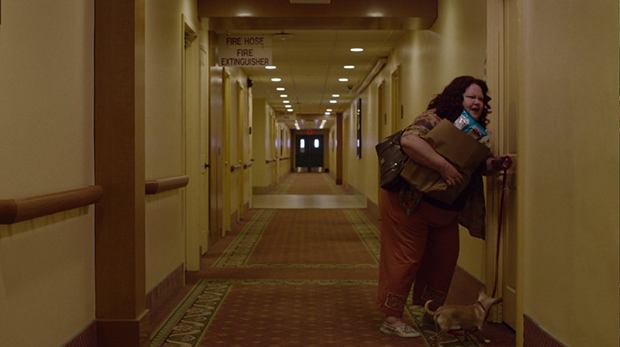
Marjorie in the Building's Hall
(3) Receiving no answer, Marjorie goes to her own apartment, #218. As the giant had told Cooper to remember "4-3-0", the viewer will be taking note of all numbers encountered.
As she opens her door we have a better view of her over-shirt and that it is covered with bright pink-red roses. We may be reminded of blue roses.
Cooper had also been told to remember "two birds with one stone". As Ruth enters her apartment we see a bird in a cage. Again, the viewer will be taking note, "Not two birds, this is only one bird."
There are details enough in the living room of the apartment to tell us, perhaps, a little something about Marjorie. The furnishings are a combination of mid-20th-century retro (side tables, lamps) and a type of middle class floral sofa, an octagonal coffee table, and matched set of armchairs, that could be either from a Buckhorn purveyor of fine furnishings or a yard sale. Marjorie seems neat and devoted to her dog. We see her dog's food bowl beneath a coffee table, and a bed for her dog on a chair.
Using a green landline, Marjorie calls 911 to inform them about the odd smell next door. She has difficulty remembering her address, and the viewer makes note of this as perhaps odd though it needn't be that peculiar at all. She could be simply upset.
MARJORIE: Oh, yes, hello? Yeah, you don't know me. This is--this is Marjorie Green. But my neighbor, there's something wrong. Yeah, I haven't seen her in three days. Oh, and then there's that terrible smell. And Armstrong smelled it in the, then I smelled it...no, no, Armstrong's my dog. No. Oh, my address? Oh, I, I, I don't know. Oh, my goodness. Um, yes, oh, I know this. You know I know this.
(4) Cut to the hallway, the same long shot we had when Marjorie (Melissa Bailey) was walking down it with her dog and they
discovered the smell coming through Ruth's door. Now empty, the airy silence of the hall is ominous. (5) Then we have a close-up shot of Ruth's door handle and we see that though the bright yellow hallway seems to be in pristine condition, the paint on the wall next to Ruth's doorknob is scratched up. We have just observed a terrible slasher-style attack in New York, so we see the scratches, know there is a bad smell, and expect the worst. This isn't going to be a skunk.
It may be that the little dog, Armstrong, is intended to allude to The Arm. Not to mean that the dog is "the arm", but that there is some word play here with the name.
(6) Cut to a police car pulling up in the parking lot before the building.
(7) Two officers exit. These are Officer Olson (Christopher Murray), and officer Douglas (James Giordiano).
(8) Marjorie, dog in her arms, rushes down the steps of her building to the green gated entrance that is open. She greets the police. MARJORIE: It was a funny thing, I couldn't remember my address when I called you on the phone.
(9) Olson and Douglas from behind Marjorie's left. OLSON: Where's the smell coming from, Mrs. Green?
(10) Marjorie gasps, as if she had forgotten her reason for calling them and is now remembering it with some horror.
(11) The officers again from Marjorie's left. MARJORIE: Oh! Oh...
(12) Marjorie turns to lead the officers through the gate inside.
(13) The officers follow.
We are given a glimpse of the passenger side of the police car. Painted on its left rear is 911, but painted before the passenger door is 116. The inverse of this will not read 911, as it should, for we have a 6 rather than an inverted 9. We have the same on the driver's side of the car as well. One has to be upside down for 116 to read 911.
(14) Cut to the hall of the apartment building again, Marjorie leading the officers down it, this time an opposing view. They stop at #216.
MARJORIE: Oh, there it is again. There's that smell.
(15) The officers sniff, mutually acknowledge the odor and knock on the door. Olson begins to glove his right hand.
(16) A shot of Marjorie.
(17) As Olson slips on his right latex glove. "Ooooh," Marjorie says, increasingly concerned. Olson tries the doorknob, finding it locked.
OLSON: Ma'am, is there a manager onsite with a key?
(18) MARJORIE: Oh, I don't know. Barney's usually here.
(19) Cut to a shot of the officers from Marjorie's left.
(20) Back to Marjorie. MARJORIE: Do you want me to go check?
(21) The officers. DOUGLAS: Yes, ma'am, if you don't mind.
(22) MARJORIE: Oh, I just remembered, Barney's not here.
(23) Back to the officers from Marjorie's left, Olson gloving his left hand. MARJORIE: He's a funny one, that Barney.
(24) Back to Marjorie. MARJORIE: He's in the hospital, not the regular hospital.
(25) The officers from Marjorie's left. Olson signals Douglas to make a call. DOUGLAS (calling in): Hey, uh, Darlene, we're gonna need a locksmith over at 1349 Arrowhead...
(26) Marjorie looks on, quizzical.
(27) DOUGLAS: Possible 10-54.
(28) Marjorie from Douglas' right. She corrects him, thinking he's gotten the address wrong. MARJORIE: No, no, 1349.
(29) The officers from Marjorie's left. OLSON: Ma'am, who lives in this apartment?
(30) Marjorie from Douglas' right. MARJORIE: That would be Ruth, Ruth Davenport.
(31) The officers listening. MARJORIE: And I just remembered something.
DOUGLAS: What's that ma'am.
MARJORIE: When Barney's out of town...
(32) Marjorie from Douglas' right. MARJORIE: ...he leaves the keys with his brother.
(33) The officers from Marjorie's left. OLSON: And who would that be?
(34) Marjorie from Douglas' right. MARJORIE: Oh, I don't know. Um, I've never met him. But Hank would know him.
(35) The officers. DOUGLAS: Who's Hank?
MARJORIE: Barney's friend...
(36) Marjorie from Douglas' right. MARJORIE: Hank Fillmore.
(37) The officers. OLSON: Where would we find Hank?
(38) Marjorie from Douglas' right. MARJORIE: Oh, well, I don't know right now.
(39) The officers. MARJORIE: He's our maintenance man.
(40) Marjorie from Douglas' right. MARJORIE: but I saw him out back a little while ago.
The officers leave Marjorie to to look for Hank.
(41) Cut to a man in a utility suit, carrying a trash bag and a small valise. He walks a leafy pathway next the building. (42) The officers pass a fire escape, walking down the sidewalk past their police car outside the building's fence. (43) The man in the utility suit sees the officers. (44) The officers see him and are about to call out to him when he calls out first.
(45) HANK: Harvey? Harvey, you son of a bitch!
(46) The two officers. DOUGLAS: Are you Hank?
(47)
HANK: What the hell...
We are confused. Who is Harvey? Is Harvey a police officer? Or did Hank think Harvey might be with the police officers? Obviously, Hank is up to no good.
(48) The two officers.
OLSON: Police, Mr. Fillmore. We need your help.
(49) Hank from beyond Olson's left shoulder.
HANK: Did Harvey send you?
(50) The two officers.
DOUGLAS: Mr. Fillmore, we need a key for Ruth Davenport's apartment. We're trying to find Barney's brother.
(51)
HANK: Well, who told you I was going to see Chip?
(52) The two officers.
OLSON: Who's Chip?
(53)
HANK: That's Barney's brother.
(54)
OLSON: We need a key from Chip.
(55)
HANK: I was just on my way, but how did you know?
(56) The two officers.
DOUGLAS: Well, do you have a phone number for Chip?
(57)
HANK: Oh, no, no, no, no, no. Chip? Chip ain't got no phone.
(58) The two officers.
OLSON (to Douglas): I'll wait for the locksmith.
(59) Marjorie on the fire escape.
MARJORIE (calling from the stairs): Excuse me! Do you think that maybe Ruth's out of town?
(60) The two officers from Marjorie's vantage point.
OLSON: Why?
(61) Marjorie on the fire escape.
MARJORIE: Well, it would be a shame because I'm supposed to water her plants when she's out of town. I have the key. She holds up a key, dangling it beside her own key that she wears on a red bracelet about her wrist.
(62) The two officer's from Marjorie's vantage point.
OLSON (to Douglas): Let's go.
(63) Hank beside the trash cans, having deposited the bag of trash there.
HANK: Am I, am I free to go? Gentleman, am, am I free to go?
That bit of comic relief over--helpful Marjorie absent-mindedly leading the police on a hunt for a key she's had all along, and Hank (Max Perlich) being clearly a person who has had encounters with the law and worried that Harvey may have called the law on him for some reason, likely due Hank having done something criminal--Lynch cuts back to (64) Ruth's door and gloved Olson using Marjorie's key to let himself in.
(65) Suspenseful music as we view the officers inside Ruth's apartment, Douglas closing the door. We see the painting of a yellow rose in a jar set atop some books and are reminded of the yellow rose that Lucy had stuck in her pencil caddy.
(66) A brief panning view of a corner of Ruth's apartment, starting with a wooden bookcase, full of books, holding also an old radio, a duck decoy set atop it. One of the books on the case is Indian Heritage, another is American Image, and yet another is Dreamland, by Kevin Baker, a novel on the seedy side of early New York. What might stand out to the viewer is the idea of dreamland. The camera pans down to show an end table beside a sofa and the edge of a blue armchair. (67) Return to the two officers. (68) A shot of a wood and glass credenza on which are some candlesticks, an old clock, a brass lamp, a decorative jar, and a large decorative magnifying glass.
We don't know if Marjorie will get more air time or not, and the same with Hank. We suspect that Ruth won't get more air time than her apartment does because it's a good bet that Ruth is dead. But Lynch/Frost manage to make these small characters stand out and have meaning in their briefly allotted screen time. The scene with Marjorie is a hallway to other stories waiting in the rear that may or may not be explored. Characters met in passing manage to be substantial in their not giving the expected answers. Peculiarly, in the original Twin Peaks we sometimes did not see the homes of major characters, while we were given an opportunity to see more incidental characters in their home settings, perhaps because the home setting helped to establish them as being of substance. We never saw the homes of Harry Truman, Lucy Moran, Andy Brennan, Hawk, Norma, or Dr. Jacoby. We never saw Audrey in her bedroom. The homes of these characters were instead, by and large, their work situations.
(69) A shot of Douglas and Olson from the right, Douglas looking past the camera. (70) We see what Douglas sees. Down the hall, through an open door, is a blue wall of Ruth's bedroom, the edge of her bed observed, and the bed table beside it. (71) As in shot 69, Douglas draws Olson's notice to the bedroom and they both move toward it. (72) A shot from their view as they pass down the hall, there clearly now appearing to be someone in the bed. (73) A shot of Douglas and Olson, from the front, coming down the hall and entering the bedroom. (74) Again, from the vantage point of the officers, the bed. A blue blanket covers a large figure in it. Our initial response is this seems to be far too large a figure to belong to a woman. We see the top of a head. (75) Douglas and Olson. "Uh oh," Olson says. (76) A close-up of a woman's head against a pillow, face-up. Ruth Davenport (Mary Stofle), a woman with red hair, has been apparently shot in the left eye.
(77) Cut to Hank by his truck calling Harvey, still holding the little black valise. HANK: Harvey, you son of a bitch. Did you send the cops to my place of business? My work? Yes! Yeah, I got it. (He places a hand on the valise.) I got all of it right here, but it's mine and Chip's. No, you opted out of this one, you remember? Harvey! Harvey don't, don't threaten me Harvey. Harvey. Harvey? Harvey has hung up on him.
Just in case we weren't clear on Hank having been up to no good, just as Norma's husband, Hank, was never up to any good, it's now evident he is and that Barney's brother, Chip, is up to no good either. We don't get the read that this has anything to do with Ruth Davenport though, as Hank didn't seem at all perturbed by the police needing keys to get into Ruth's, nor does he seem concerned that the police are at that moment in Ruth's apartment. It's pretty obvious that Hank has no idea what's lying up there in Ruth's bed.
(78) Cut to shot 76 again and the flash of a camera going off in Ruth's bedroom, the crime scene being photographed. (79) A view of the photographer and Olson beyond. (80) Briefly, we see the coroner, Constance Talbot (Jane Adams), taking notes. (81) Back at the front door to the apartment, Detective Dave Macklay (Brent Briscoe) enters by ducking under the "Do not cross" tape. He proceeds to the bedroom. (82) Dave and Olson in the bedroom. (83) Ruth Davenport's gory face. (84) Dave and Olson. "Constance?" Dave says. (85) When she looks at him, he raises his hands to show he wears blue gloves, ironically holding them in the posture of a person with a gun on them. "Good for you, Dave. You're behaving yourself for a change," she says, which suggests that he perhaps often forgets to wear the latex gloves. (86) Another view of Olson and Dave, Dave's hands still held up.
One might look at this as a link back to New York, when Sam had called Tracey a "bad girl" for looking over his shoulder when he was entering his code. In contrast, Dave is good. He is going by the rules. These may seem to be unrelated things but "bad" Tracey was murdered with Sam, and Dave is about to discover something even more disturbing about this murder scene.
(87) Constance asks him, "Want to help me with this?" (88) Olson and Dave. Dave advances toward the bed. (89) A view of the bed with Constance to the left and Dave to the right. We again observe the blanket seems to be covering a form far too large to belong to the face of the woman on the bed. (Now is when it occurred to me the blue blanket may refer to Blue Velvet.) "Very Carefully. Keep it way up, off the body," Constance tells Dave, as he helps her lift and pull back the covers. (90) A view from the bed of white sheet rising before the camera, Dave still pulling it back as Olson, horrified, comes into view. "Uh oh," Olson says. (91) Now the viewer sees what Olson sees, that Ruth's head may be resting on the pillow, but the headless body of a large and heavy male is resting beneath it. The bottom sheet of the bed is stained with blood. (92) A closer shot. (93) A closer shot.

In the Bedroom #2
(94) Cut to Constance standing beside the photographer. She glances over at Dave. (95) A last view of the body, from Constance's vantage point. Zoom in. The screen darkens.
With the discovery of two murders, not just one, Olson is given the opportunity to say his, "Uh oh", twice.
The gender-bending theme continues. With the introduction of C, "American Woman" had played so slowly that it sounded like a man singing rather than a woman. Mr. C had been wearing a barette in his long hair but otherwise was "masculine". Jerry may have been wearing his mother's knit hat. The figure that appeared in the glass box had at times appeared to be feminine, and at other times androgynous, but the head was that of a monster, a blob with no identifying features, only possessing a mouth. Now, we have a woman's head positioned with a man's body.
We are aware that Major Garland Briggs, of Twin Peaks, had a body type similar to that lying on the bed. Could the body be his?
The in-the-meanwhile story about Garland Briggs is in Frost's The Secret History of Twin Peaks. He had a meeting with Cooper, on March 27th, 1989, after Cooper's having left the Red Room. Briggs had been selected by a Colonel Doug Milford to serve as his replacement at a secret facility, near Twin Peaks, that was called Listening Post Alpha (LPA). Milford had told Briggs, "I'm the white rabbit, drawing you closer to the rabbit hole. And like the rabbit, I'm late for a very important date. You're my replacement, Garland. You're going to become the Watcher in the Woods." The mission was to "detect signs of intelligent nonhuman life not only in deep space" but on earth. Colonel Milford was Briggs' "control". When Milford died in March of 1989, at the same time Briggs found himself supernaturally abducted, during which he had an intense life-altering experience. Upon his return, he found Milford had died three days earlier and left him a message, that he was not to act alone but wait for his new control to appear. Briggs had determined that new control must be Cooper, for which reason he'd arranged the March 27th meeting with him. After that meeting he was concerned that something was wrong, he'd misinterpreted, and stated he was going to LPA to send out a Mayday signal. That was the last known of Garland Briggs.
Twenty-five years later, here lies the body of, we suspect, Major Briggs. A crime such as this, placed to be found rather than hidden, is intended to communicate a message. We consider that Mr. C might have something to do with this. To whom is he sending the message?
And who is Ruth Davenport? And what has she to do with Major Briggs? One reasons they must be connected somehow for her head to be left with his body. If this is Briggs.
SOMETHING'S MISSING
MY LOG HAS A MESSAGE FOR YOU / A BIT OF HISTORY OF MARGARET AND HER LOG / HAWK'S HERITAGE
(1) About 43:27. Cut to a scene of woods so dark we are unable to decipher much of anything. So the shot is more a matter of what we hear, which is wind through the trees. (I have read that Lynch, when making Eraserhead, consistently wanted things so dark that tech considered it problematic.) (2) Cut to the soft light of a window in the dark. The wind has dampened and we hear bugs singing. (3) Then to the Log Lady, Margaret Lanterman (Catherine Coulson), holding the phone in one hand, the log embraced in her other arm, seated next a small table. She wears a breathing tube, her hand is shaky, and she appears weak. Catherine Coulson had been battling cancer, and her presence touches all viewers long familiar with the show.
(4) Cut to a black press button phone. Lucy's voice on the intercom informs Deputy Hawk that Margaret Lanterman is on line one. "Deputy Hawk, Margaret Lanterman's on line one. It's the line with the light that's blinking." (5) Deputy Chief Hawk in his office. He has a "totem pole" lamp and before it a small, decorative log cabin on his desk. The little decorative log cabin would seem to connect him with Margaret, who lives in a log cabin deep in the woods. Thanking Lucy, Hawk answers the phone.
HAWK: Margaret, what can I do for you?
(6) MARGARET: Hawk, my log has a message for you.
(7)
HAWK: Okay.
(8)
MARGARET: Something is missing and you have to find it. It has to do with Special Agent Dale Cooper.
(9)
HAWK: Dale Cooper? What is it?
(10)
MARGARET: The way you will find it has something to do with your heritage. This is the message from the log.
(11)
HAWK: Okay, Margaret. Thank you.
(12)
MARGARET: Good night, Hawk.
(13)
HAWK: Good night, Margaret.
The conversation is natural but has a stilted quality due lengthy, intentional pauses between responses, these taking on their own special and significant weight.
One may recollect that back in Ruth Davenport's apartment there had been the book, Indian Heritage, which is a connection between the two scenes. Also, the apartment was at 1349 Arrowhead and arrowheads will lend one to think, "Oh, like Hawk's heritage."
Hawk now entering the story, we may be reminded of the giant telling Cooper to remember "two birds with one stone". A hawk is a bird. We had just previously observed a bird in Marjorie's apartment. My noting this isn't to be misconstrued as these being the two birds. The viewer has been alerted to birds and stones by Lynch and so they will be attentive to any and all birds and stones even though "two birds with one stone" is an idiom.
What is missing? Currently the viewer knows that, back in Buckhorn, Ruth's head is missing the rest of its body, and a man's body is missing its head. Even a brief acquaintance with Lynch/Frost is enough to let a viewer know that what the log points to as missing and must be found may not be the missing head or body. These are just other things that are missing.
Margaret was an enigmatic presence in the original episodes, her log offering messages, some of which were puzzle pieces as cryptic as any others supernaturally received, but there were also those that were direct and emphatic, such as the time her log told Major Briggs to "Deliver the message" and he understood immediately what that was about.
What we knew of Margaret was that she was a widow who lived deep in the woods, her husband, a woodsman, having perished years before in a fire. Frost's Secret History of Twin Peaks clarified that Samson Lanterman, also a volunteer firefighter, had perished the day of his and Margaret's wedding, the single casualty of a sudden wildfire he left the wedding reception to fight. Due the manner of his death, and that he was the only casualty, we are given the feeling that somehow he may have been selected to die by mysterious otherworldly forces. With his death, Margaret had selected a felled piece of a Douglas Fir at what she called the "Heart of the Forest", near Glastonbury Grove, where she had once disappeared as a child (an abductee), and also where her husband, Samson (Sam), had proposed to her. It was also where Sam had been killed, the wildfire sweeping through that area but leaving the sycamores of Glastonbury Grove untouched. Thereafter she was inseparable from the log by which she received the cryptic messages she was to relay to others.
One questions why Margaret's Sam was called away from their wedding reception, before they had an opportunity to consummate their marriage, their courtship having been given as so entirely proper that it harkened back to the morality of a former century. One wonders why the story would demand that kind of propriety, why Sam and Margaret would be denied their wedding night.
Does it mean anything that a man named Sam has just been killed by a mysterious something in New Work, while he and Tracey were in the act of sexual foreplay, and that Margaret now has a message to pass on from her log? We don't know.
One of the stories of the inception of Margaret's log is that it was an idea that came around at the time of Eraserhead, Lynch envisioning Catherine holding such a log. The initial idea was that the log would be the anchor point of a series of shows in which the viewer was introduced to different situations such as dentistry. The log would be the querying intermediary. However, I have wondered if we can go back to Lynch's Grandmother and see in it a version of the log. A lonely, abused boy takes a seed and plants it in a mound of earth upon a bed. From this grows a thing that is both fleshy, tree-like, as well as pod-like, and this ends in birthing a grandmother to whom he goes for comfort.
Tommy "Hawk" Hill, Nez Perce Indian, was a bit of a mystery himself in the original series. He respected Margaret, believing the forest held supernatural mysteries, cognizant of the White Lodge and the Black Lodge. He was a fixture by virtue of the sheriff's department, his home life not investigated by the show, he having no story lines apart from investigations, so that at the end of the original series he was another for whom there were no cliffhangers.
Hawk was trusted enough by Cooper that he had once said that if anything happened to him he hoped they would send Hawk to find him.
Thus far, The Return, in respect of Twin Peaks characters, has focused first on reintroducing its mystics from the original series. One might argue that the Hornes shouldn't be counted as mystics, but Jerry should perhaps be due his drug experiments and their creative, solitary sojourns. He, like Jacoby, Hawk, Margaret, and Lucy, reside in, or comprehend and accept, alternate mind spaces.
Margaret is the first, in The Return, to mention Dale Cooper, and the one to initiate a search for something missing relative to this man who has been absent for twenty-five years. She does not ask Hawk to search for Cooper, instead it's something missing that has to do with him, which is an interesting distinction.
IDENTIFYING PRINCIPAL HASTINGS IN BUCKHORN
(1) About 45:16. The brick exterior of the Buckhorn Police Department. Day. (2) Then to Constance at her computer doing a print analysis. We see her at her computer screen bringing up the prints. (3) We have a shot showing Constance's office so we orient her and her desk in it. On her desk rests a large flashlight. Stuck in with her stapler is either paper that is shaped like a blue flower, or one of the latex gloves is tucked in it and gives the appearance of a blue flower. (4) Constance's computer screen as it begins scanning for a match. (5) Constance drinking her coffee. (6) Back to the computer screen scanning the CODIS database. A positive match returns. (7) The scan returning a positive match, she excitedly calls, "Dave! Dave!" (8) A shot of old wood file cabinets in a short corridor separating Constance's office from Dave's. We hear Dave say, "On my way!" He enters. (9) Back to Constance. She tells him, "You've got to see this. The head is definitely Ruth Davenport, the woman who lived in the apartment." (10) Dave listens as she says, "And we've got a male John Doe." (11) Back to Constance at her desk. "We don't know whose body that is. Nothing's come back on those prints, but there's another set of prints all over the apartment, and we've got a hit, a definite local hit."
(23) We see on Constance's computer screen the face of William Hastings who lives at 439 E. Elm Street. His license is H62499840. His height is 6 foot 3. His birthdate is August 15, 1973. His weight is 215 and his eyes are blue. The issue date is August 15 2012, the expiration date being in 2017. Alongside Bill Hastings' face, the four heads of the presidents on Mount Rushmore decorate the license. "Bill Hastings?" Dave says.
(24) Dave, looking on, remarks in surprise, "Oh, my god". Constance says, "Yeah, he's my kid's principal." (25) Cut briefly back to Bill Hastings on the computer screen.
A respected, trusted member of the community has prints all over the apartment of Ruth Davenport which is the scene of a terrible crime. We are entering Leland Palmer territory, the trusted lawyer who killed his daughter, Laura, but was also possessed by BOB.
THE PRINCIPAL, BILL HASTINGS, TAKEN INTO CUSTODY
(1) About 46:34. Cut to police cars pulling up before a long brick pathway that leads up through a well-manicured lawn to a house, we viewing from the perspective of the house. Over a wall across the street we see blue flowers. Dave exits the detective car and walks the pathway to the house's door (2) on which is a decorative wolf's head knocker that is mundane middle America and yet also Red Riding Hood sinister. He knocks and a blond woman answers who is actually of an age and type to be Laura Palmer, had she not been killed, twenty-five years on. The woman remarks in surprise, "Dave!" He asks, "Phyllis, is Bill home," cutting her off. In the background we hear a man's voice calling, "Who is it, honey?" Phyllis (Cornelia Guest) calls out, "It's Dave. Dave Mackley." (3) A shot of Dave from Phyllis' right.
(4) Return to the doorway, as seen from Dave's left. Bill Hastings (Matthew Lillard), looking as friendly and innocent as can be imagined, approaches the door smiling, greeting Dave, asking, "What's going on, buddy?" (5) Dave tells Bill, "Bill, I'm going to have to put you under arrest." (6) Bill reacts in surprise, "What?" (7) He's told, by Dave, "Please turn around. I've got to cuff you, and I've got to take you in." (8) Return to a shot of the doorway from outside. As Dave handcuffs Bill, Phyllis exclaims, "Oh, my god, Bill!" Bill says, "My god. It's okay, I haven't done anything wrong. Can you tell me what this is about?" Dave responds, "We can talk about that at the station." Phyllis says, "I want to come with you." Bill tells her, "No, no, stay here. There's been a mistake." (8) A shot from Phyllis' right, looking out the door. "I haven't done anything wrong," Bill says as Dave leads him away, reciting to him his Miranda rights. (9) A close-up of Phyllis as she calls out, "But the Morgans are coming to dinner!" (10) Bill, being led to the police car, saying he understands his Miranda rights, calls back to Phyllis, "Just call George and tell him where I am!" (11) A close-up of Phyllis nodding assent. (12) A shot from her right of Bill being put in the detective's car.
George would no doubt be Bill Hastings' lawyer. (13) A last shot of Phyllis watching.
Bill Hastings' license had shown him with a mustache. He has since rid himself of it so he doesn't look exactly as in the photo.
With the Hastings household, Lynch/Frost now give the public the equivalent of the happy-on-the-surface, suburban American dream lifestyle that is exploded in Blue Velvet and Twin Peaks. The sunny side can harbor a dark undercurrent and you never know under what entirely unassuming cover it sizzles. There is nothing odd or outstanding about the house. Everything looks normal in as much as it projects conformity to the brand that is the middle class. The streets of America are lined from end to end with such houses, and advertisers encourage their denizens to live immaculately organized lives with all the protections that money can buy against dread of future catastrophe or even minor inconvenience.
Off to the side, in the foyer, through a side window of the door we are given a brief glimpse of a photograph hanging on the wall. It is so brief in this scene that I will wait to discuss it at the end of the analysis for this episode.
After some long sections, with the murder of Ruth Davenport the pace picks up, the story line seeming to move along rapidly with the ID of Bill and his arrest. But we know from the original episodes that nearly an entire town can end up suspect of a crime and Bill may have nothing to do with these murders at all. Or he just might! Though it would seem a rehash of old territory to have Bill become a kind of Leland, so we seriously doubt that's where we're heading. Because we doubt Bill will be made into another Leland, and due to Bill's being so quickly associated with Ruth's death, it's almost certain that we're going to find out he's innocent.
THE BOXES OF THE LAURA PALMER CASE FILES ARE BROUGHT OUT OF STORAGE
THE STORY OF WALLY, WHO WAS OF UNCERTAIN PARENTAGE IN THE ORIGINAL SERIES / ONE-EYED JACKS AND MARLON BRANDO / PROSPECTIVE MANY-WORLDS THEORY ONLY PLAUSIBLE EXPLANATION FOR WALLY'S BIRTHDATE / THE PECULIAR BRENNAN FAMILY PHOTO / WHAT THE NOVICE VIEWER WILL TAKE FROM THIS EPISODE AS OPPOSED TO THE SEASONED VIEWER
(1) 48:19. Back to Twin Peaks. Hawk carries two boxes down a corridor into the conference room of the sheriff's department and sets them on a table. (2) The boxes, evidence from Laura Palmer's case, are marked with big red Xs. One may be reminded of the prominent X design in the ceiling of the glass box in New York. In the conference room, Hawk reads the description on the top of box. (3)
Deputy Andy Brennan enters with his wife, Lucy.
HAWK: She said something is missing and it has to do with Agent Cooper.
LUCY: But Agent Cooper is missing... (4) Shot of Hawk as Lucy continues. ... and he hasn't been seen or heard from... (5) View of Lucy and Andy from Hawk's left. LUCY: ...since before Wally was born and Wally's 24 years old.
ANDY: He was born on the same day as Marlon Brando.
(6) Back to a shot of Hawk listening. LUCY: Andy wanted to name him Marlon... (7) Return to a smiling Andy and Lucy seen from Hawk's left. LUCY: ...and we haven't even gotten a Christmas card from Agent Cooper.
ANDY: He hasn't even seen Wally.
(8) Hawk interrupts. HAWK (stopping them): Andy, Lucy, it's late. (9) Shot of Lucy and Andy stiffening. (10) HAWK: Go down to storage and get those files we talked about. (11) Shot of the three from Hawk's left. HAWK: Tomorrow morning, lay 'em all out. (12) Shot of Hawk. HAWK: I'll bring the coffee and the doughnuts.
(13) Lucy and Andy. LUCY: Okay, Deputy Chief Hawk.
(14) Hawk nods and returns his focus to the boxes.
Andy and Lucy formed a "whole" in the original series, their story lines intertwined and dependent upon one another. We may not have seen their home, but their home life, as this "whole", was a staple of the sheriff's department. Like Lucy, Andy is an innocent fool. Indeed, one of Andy's problems at first was that he cried at crime scenes, so distraught by them was he, so he made for a very unlikely deputy as tragedy and the evil that people can do always stirred in him a profound, sympathetic grief. Of course, this is also why he was endearing as a deputy.
When Lucy and he first learned she was pregnant, they had a falling out as Andy believed he couldn't be the father due his low sperm count, and it was revealed that Lucy had reason to believe Dick Tremayne could possibly be the father, a person with whom she'd had a relationship while she and Andy were briefly separated. Later, Andy found that his sperm count had rebounded so it was, after all, within the realm of possibility he could be the father. At the end of the original series, not knowing yet who the biological father was, Lucy chose Andy as the person who would be the child's father, which left Dick clearly relieved. That resolved, Andy eager to be a father, the cliffhanger of who was the biological father didn't much matter. That still is not answered here, perhaps because who was the biological father didn't matter then and doesn't now. But the viewer would wonder at why both Andy and Lucy feel the need to regale Hawk with the story of Wally, which he has likely heard a thousand times before, for which reason he politely but firmly stops them and reorients them on business. Likely, in the interest of informing the viewer a little on Wally (acquainting the fresh viewer who doesn't know the previous episodes), the opportunity to present some history is done in line with the fool's aspects in Lucy and Andy's characters, which have begun to really wear on Hawk, seemingly, over the past twenty-four years. He's annoyed, and Lucy becomes annoyed that he's annoyed, and shows her annoyance by calling him "Deputy Chief Hawk" instead of Hawk. She feels he is pulling rank.
The account of Wally's birth is a "meanwhile" story and I don't believe is even in The Secret History of Twin Peaks book. We only learn now of Wally's name and of the special nature of his birthdate.
A problem with sharing Marlon Brando's birthday is that Brando was born April 3, 1924 and the events of the original series were in February and March of 1989. How do we reconcile Lucy being pregnant in March (perhaps February) of 1989 and the child being born in April of 1990? It's impossible to do as that's a pregnancy of about fifteen months. There's also the problem of what year this is, Later indications are that it is 2016, though 25 years after Cooper's disappearance would be 2014. So there must be another way to rectify these things. Indeed, there are a number of differences in Twin Peaks "facts" between the series and the Secret History, and even Fire Walk with Me. Such as dramatic differences between the story of the romance of Ed and Norma and how Nadine and Ed got together. Frost said before The Return these would be explained. The only explanation I can think of are alternate story lines through a many-worlds theory. But I prefer not to go there at the moment.
If we return to the earlier receptionist scene of Lucy, in the background we see a black-and-white "family photo" of Lucy, Andy, and their son. I had noted the playing cards spread out on Lucy's desk, the prominence of the Jack of Hearts, and gave a little history on the One-Eyed Jacks brothel/casino from the original series.
The Jack of Hearts card also ties in with this family photo due Wally sharing the same birthdate as Marlon Brando, and having the middle name Marlon. One-Eyed Jacks was a movie that Stanley Kubrick was originally planned to direct, but Brando, who starred in it, ended up directing the film instead. A line from that movie, relevant to all of Lynch's work, is, "You may be a one-eyed Jack around here, but I've seen the other side of your face."
This family Christmas photo is obviously peculiar even at a distance. On closer examination one finds the heads of Andy, Lucy and their son appear to be very poorly photoshopped onto another image. Thus, the family portrait is an artificial construction. The viewer is left to wonder at the why of this. Certainly there must have been other photos of the three together memorializing them as a family. So why this creation that is several different parts of photos so badly stuck together?
With this little story offered by Andy and Lucy, we have our first brief "in the meanwhile" account of how Cooper has been missing for twenty-five years, which to Andy and Lucy means that he's not participated in friends and associates keeping in touch through cards at important holidays and honoring the important life events of others, such as the birth of a child.
If we think about it, the novice viewer so far only has any history on Cooper and the original seasons from the story of Wally. The novice viewer will have no idea who Jacoby was, no idea who the Hornes were. They will have had no idea who Lucy was when they see her with the insurance man at the Twin Peaks Sheriff's Department. They don't know who Margaret is, or Hawk. The most that they learn of the Twin Peaks side of things is through this story of Wally, who's 24, and orients happenings so the 25 years projection given at the beginning now has a slim bit of context in reference to this child that hadn't even yet been born when the second season ended. Indeed, everything in this episode that has to do with Twin Peaks is piecemeal and for all intents and purposes devoid of story until this character named Hawk gets the assignment to look for something missing. If one is a new viewer, one is instead going to be more attached to what happens in Buckhorn and in New York, those scenes presenting action and some character development rather than being poetic in tone, for the Twin Peaks sections are, for now, largely poetic and absurdist for someone unfamiliar with the first two seasons. The new viewer is going to be instead only connected to the new characters: Tracey and Sam, who have already been killed off, and Constance, Dave, Margaret, Hank, Bill and Phyllis. The novice viewer doesn't even know anything about Laura Palmer--though I will assume they are aware she was a girl who was killed, and whose death brought Cooper to town originally. If they haven't seen the first two seasons, however, this Return, thus far, has nothing to do with Laura Palmer except that, at the beginning, she appears to promise to see Cooper in twenty-five years, and if they don't happen to know anything about Laura Palmer they don't even know who she is. So, the most visceral scenes for that new viewer, as far as building plot and character development, are going to be New York, Buckhorn, and perhaps the one with Cooper's double. Whereas, for the returning viewer, the New York and Buckhorn scenes are all fringe characters to whom they have no emotional connection.
Side note. Is Wally Brennan a reference to character actor Walter Brennan and his game-leg deputy of Rio Bravo?
HASTINGS QUESTIONED
THURSDAY NIGHT AS AN ANCHOR FOR THE VIEWER / SOMETHING WRONG WITH HER...
(1) 49:29. Return to the facade of the Buckhorn Police Department. (2) A closer shot of its door. (3) Inside, Bill Hastings sits at a table in an interrogation room, holding his head, a plastic cup of water resting before him. (4) Police Chief Mike Boyd (Dep Kirkland) enters the adjoining observation room and introduces Detective Dave to Don Harrison (Brent Briscoe), State Police from Rapid City.
DAVE: Are you taking this case?
DON: It's your's Dave. (5) Don from behind Dave, shaking his hand. DON: Just here to help. Any luck with the missing body and head?
(6) View of the three with Bill seen through the window in the interrogation room.
DAVE: Nothing.
DON: How long's he been in there?
DAVE: About half an hour.
DON: That's enough.
DAVE: You sure you don't want to take this?
DON: Mike said you're fishing buddies.
DAVE: I've known him since high school.
DON: He might tell you more than he'd tell me. Go on in.
Dave enters and sits down to question Bill. (7) Boyd exits the adjoining room as Don watches.
DAVE: I'm sorry about the delay. Did they get you some coffee?
BILL: I'm good with the water.
(8) Bill from behind Dave.
BILL: Can you, can you, uh, can you please tell me what's going on?
DAVE: We'll get to that but I have a few questions that I have to ask you first.
(9) Dave from Bill's right.
DAVE: Um, do you know a Ruth Davenport?
(10)
BILL: The name sounds familiar. Uh, the librarian?
DAVE: Yes.
BILL: Ah, okay.
(11) Dave from Bill's right.
DAVE: That's her. Do you know her?
(12) Bill from Dave's left.
BILL: Not really. We say hello to each other.
DAVE: Mmm. When did you see her last?
BILL: Oh, I don't know. Uh, let me think. Maybe a couple months ago?
(13) Dave from Bill's right.
DAVE: Have you ever been to Ruth Davenport's home?
(14) Bill from Dave's left.
BILL: No, I've never been there. I don't, I don't, I don't even know where she lives.
(15) Dave from Bill's right.
DAVE: Mmm-hmmm. Have you ever been to the apartment building at 1349 Arrowhead Road?
(16) Bill from Dave's left.
BILL: No, I never have. (Nervously clears throat.)
(17) Don watches in the observation room. BILL: I've, I've, I've never, I've never been there. Could, could you please tell me what this is about?
Don asks the officer if he has gotten the warrant, and the officer replies any minute, that "the judge was up the mountain."
(18) View of Bill and Dave from behind Boyd and Don.
DAVE: Bill, can you account for your time over the last three or four days?
BILL: Sure, yes, I can.
(19) Don and Boyd from the left.
BILL: I've been at school every weekday.
DAVE: And evenings?
BOYD: Our high-school principal.
BILL: Uh, Wednesday, I went home right after school.
(20) Bill from Dave's left.
(21) BILL: Thursday, we had a meeting in the evening. And then, I went home. And then, uh, Friday I went out to dinner. Phyllis and I. But we went home right after that.
(22) Dave from Bill's right.
BILL: And, and I was home all day today.
DAVE: What, what was this Thursday meeting about?
(23) Bill from Dave's left.
BILL: Curriculum. Faculty evaluation. It's a bimonthly meeting.
DAVE: And when did it end?
BILL: Around 9:30, I believe. I don't know. We ordered pizza.
DAVE: And you went home directly after?
BILL: Yes.
DAVE: And what time did you get there?
BILL: 10:15, 10:20.
(24) Dave from Bill's left.
DAVE: Well, how long does it take you to drive home usually?
(25) Bill from Dave's left. (26) View of Dave's pad as he makes notations on it. A question mark.(27) Bill from Dave's left.
BILL: Um. Oh, yeah. Oh, yeah, now I remember. I gave my assistant, Betty, a ride home. (28) A dull roar has begun. Dave from Bill's left. BILL: Something wrong with her... (29) Bill from Dave's left. BILL: ...car. Something wrong. (30) Boyd and Don watching. (31) Bill from Dave's left. BILL: I think I'd like to speak to George. He's my lawyer. Is, is, is, is he, is he, is he here?
(32) Dave from Bill's right. DAVE: I can check. But, Bill, is there anything else that you would like to tell me before we get the lawyer involved?
(33) Bill from Dave's left.
BILL: Please tell me what's going on.
(34) Dave from Bill's right.
DAVE: Ruth Davenport was murdered... (35) Bill from Dave's left. DAVE: ...and your prints are all over her apartment.
BILL: What? What? (36) Dave from Bill's left.
DON (on the intercom): Show Mr. Hastings to his new room. (37) The interrogation room from beyond Don and Boyd. DON: He can meet with his lawyer there.
(38) Bill from Dave's right. (39) Dave from Bill's right. DAVE: Right, you're gonna have to come with me now, Bill. Right out here.
(40) The interrogation room from beyond Don and Boyd. (41) Dave leads Bill out of the interrogation room and to his cell. He says, at the end of a corridor, "To the left here, Bill." (42) The jail cells. "Right, right here, Bill," Dave says, directing him in a cell. As he slides the door shut, Bill asks to speak to Phyllis. Dave says he'll see what he can do, locks the cell and leaves.
The notes on Dave's pad read:
Hastings Prints - Forensics
Mult Conf.
Prior - MI Misdemeanor
1994 Speeding
1997 JayWalking
617238
Ruth Davenport - lib
yes, does know
1349 Arrowhead Way
No (illegible)
Wednesday home
Thursday meeting
Ended 9:30
Home 10:15 10:20
The viewer doesn't have to see Dave's notes to know that Bill's lying about his not being recently familiar with Ruth Davenport. He's nervous. He wants his lawyer. This person, who has only a single count each of speeding and jaywalking on his record, is hiding something. The Bill Hastings we observe is certainly terrified and he projects innocence, but he also projects guilt because there are things about his life that he is unwilling to discuss, that he doesn't want Dave to know about.
With this interview, the audience is given some timeline anchors. Not that a timeline is needed, but Lynch and Frost have been doing a good job of avoiding any up until this point, when timeline becomes finally essential. Ruth was likely murdered on Thursday and Bill was picked up on Saturday.
Based on this, and the information given thus far, we can possibly pin the murders in New York as happening on Thursday night, we know after 10:00 p.m., and Bill states he got home around 10:15 or 10:20. That's not to link Bill with the murders, no, but what was happening at around 10 p.m. on Thursday night that made for these gruesome murders in New York and Buckhorn (however New York and Buckhorn being in different time zones)?
WE'RE COMING IN
KAFKA AND THE METAMORPHOSIS / BLUE VELVET AND THE GOLD VOLVO'S TRUNK
(1) 56:42. Cut to facing the Hastings home, the police cars pulling up in front of it and officers exiting.
(2) Don approaches the door with Dave and knocks. When Phyllis answers, Don hands her a paper and tells her, "Mrs. Hastings, we have a warrant to search the house. She exclaims, "This is unbelievable. We have guests for dinner tonight." Don simply asks her, "Is that Bill's car in the driveway, ma'am," and she tells him, "It's the Volvo." He tells her, "We'll need the keys." Exasperated, she complains, "Dave..." Dave tells her, "It has to be done, Phyllis."
DON: We're coming in.
Some officers go inside while Don and Dave and others head toward the cars.
As Phyllis opened her door, we were briefly able to see a picture of Franz Kafka on the wall. Lynch has said of Kafka, "The one artist that I feel could be my brother is Franz Kafka." He had hoped, at one time, to do a version of The Metamorphosis but the project fell through. We should likely consider the metamorphosis as being present in The Return.

Kafka
(3) The officers with the gold Volvo. Dave steps around to the trunk. (4) Phyllis watches. And by the manner in which she watches we wonder at her place in all this. She seems attentive in a way that indicates she knows something and wouldn't care if the detectives find what she secretly knows about. She way too promptly announced Bill's car was the Volvo, like, "Have at it and have fun with what you find, I'll watch from the door." (5) Don and Dave move around to the trunk. (6) Close-up as they open the trunk of the gold-toned car, license plate 68N416. (7) View from the trunk's interior as Dave shines his light into the trunk. The light blinks on and off. (8) In the trunk is a fishing rod, a fishing tackle box, and a Coleman Party Storage cooler. (9) View of the men from inside the trunk. The flashlight continuing to go on and off, Dave remarks to Don that his "flashlight is broke". (10) A view of the trunk's contents. (11) View of the men from inside the trunk. (12) Don removes the cooler. (13) The men again from within the trunk.(14) View of the trunk. Under where the cooler was, resting on the blue carpet of the trunk, is a piece of flesh. Dave's flashlight strobes off and on as it shines upon it.(15) View of the men. "Woof," Dave says. Marjorie's dog, Armstrong, had pointed to something wrong in Ruth's apartment. Dave annotates his finding of the unusual with a dog's bark.(16) A close-up of the flesh. Go to black.
Just as Ruth had been found dead under a deep blue blanket, the flesh in the car is found on a blue carpet. I'm assuming these are allusions to Blue Velvet. And there is, in a good part of the Buckhorn scenes, a sensibility that bypasses early Twin Peaks and connects with Blue Velvet. The police department in Buckhorn is not as eccentric as that in Twin Peaks, having a sensibility more like in Blue Velvet, and the manner in which this flesh is found and focused upon reminds of Jeffrey's finding of the ear. The connection may be confirmed by the next scene in which we return to the gramophone, which I had already compared with the found ear in Blue Velvet.
Lynch has had flashing lights in his films since at least Eraserhead. In the original Twin Peaks those flashing lights signaled a supernatural energy afoot.
After the intro, part one had opened with ??????? stating that, "It is in our house now." Excluding the epilogue, in the last scene of part one, the detectives announce to Phyllis, "We're coming in." Investigators are in her home now, poking around, prying about for what has been hidden from view of the street by the comfortable, middle class facade. As most all fiction points out, every person's home or life, upon close examination, will reveal something that is at least unusual and apart from what is projected on the exterior. But, as I've previously stated, I think we can also look upon this as meaning that the show is in the viewer's household now, and they, like Cooper, are as detectives who are investigating what this means, looking for the clues that have been dropped.
LISTEN TO THE SOUNDS REDUX AND CREDITS
(1) 58:46. Cut to ??????? in the black-and-white room listening to the rumble and soft clicks/scratches heard over the gramophone. (2) The gramophone. As we listen to the insect-like clicks, recollect the picture of Kafka in the home of Bill and Phyllis Hastings, and how the main figure in the story of The Metamorphosis wakes one morning to find that he has become, overnight, an insect much like a cicada. Does that change the essence of who he is? Is the caterpillar the same as the butterfly? Is there even such a firm foundation as an essential self unlike any other? What of Bill? If there is a metamorphosis in the house, is he the same individual he always was or does he became a different creature?
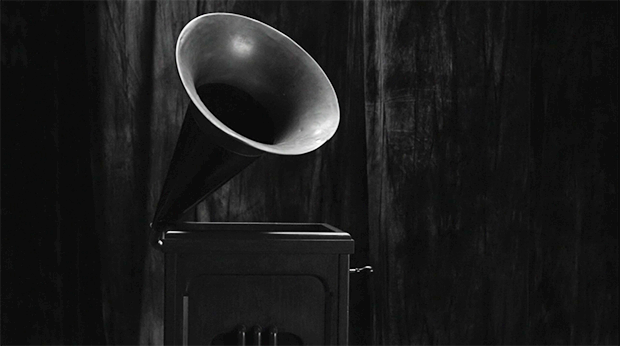
The gramophone.
At the end of the credits run, the episode is dedicated to Catherine Coulson.
SOME END NOTES
Only when the season ends does the viewer find that they will never see Buella again, they will never see Otis again or the house where Mr. C. picks up Darya and Ray, and the other mysterious inhabitants briefly glimpsed, who can be best compared to those in the place above the convenience store. The reason for Buella may be best approached via her hair style, which reminds a little of Diane's, and we may think back on Buella when we learn of Diane having been taken to the place above the convenience store.
Only when the season ends will the viewer realize they will never see Hank again and find out about his story, what he's carrying in his valise that is his and Chip's and which Harvey is threatening him over. That something illegal was likely happening is all they will know. As Marjorie had the key all along, Hank is absolutely inessential to the story, and yet he is there.
We never see the wonderful character Marjorie again either but she and her dog are in a sense refabricated and can be seen in the green glove that overpowers Bob, which I will get into later.
STAB AT A TIMELINE
The timeline for events may be the following.
1. Supernatural - B&W room
2. Jacoby's trailer, day - Wednesday?
3. New York, after 10 at night - Wednesday
4. The Great Northern Lodge, day - Thursday
5. Twin Peaks Sheriff's Department, day - Thursday
6. Buella's, night - Thursday
7. New York, 2nd night (we know this is certain) - Thursday
8. Buckhorn, South Dakota, discovery of Ruth, day - Friday
9. Twin Peaks, Margaret calls Hawk at work, night - Friday
10. Buckhorn, the coroner's, day - Saturday
11. Buckhorn, Hastings taken into custody, day - Saturday
12. Twin Peaks, Hawk, Lucy and Andy in the conference room, day - Saturday. (Lucy wears the same clothes as in the scene with the insurance salesman, but this scene and that one are separated by at least one night in Twin Peaks. Hawk had spoken with Margaret at night, at the office, but this scene is in daylight and so is another day.)
13. Buckhorn, Hastings interrogated - Saturday
14. Buckhorn, Hastings home searched - Saturday
15. Supernatural - B&W room.
Approx 26,000 words or 52 single-spaced pages. A 200 minute read at 130 wpm.
Next: Go to Part 2
Go to Table of Contents for Analysis of Twin Peaks Return
Link to the main TOC page for all the analyses


